
ISSUE 538 NOVEMBER/DECEMBER 2022 TŪ KAHA COURAGE TŪ TIKA COMMITMENT TŪ TIRA COMRADESHIP TŪ MĀIA INTEGRITY EX TOROKIKI The re-emergence of Ngāti Tūmatauenga THE LOITERING MUNITIONS EXPERIMENT HELPING UKRAINE The NZDF's continuing effort
Over the month we not only observed the actions and achievements of various junior leaders, but we purposely invested in their development. As one of the highlights of my 2022 year – it was a pleasure to sponsor the former NCO and RSM conference, the first in three years.
Our people took in the fresh information and were activated by the sense of Army plans, force-management, people and culture, recruiting strategies, and HR policies and incentives being worked on at all levels. What was truly impressive, was their (NCO attendee) commitment to traditional roles and responsibilities and leading through our unique Profession of Arms.
Let’s reflect on our successes! Fight-Survive. Our Op Tieke troops working in the United Kingdom have impressed everyone who has visited them on the ground. From the 5 Rifles UK Army hosts, through to the many dignitaries and military heads that have seen them on the Salisbury Plains – all commented on the purpose, training skill and culturalcompetence that’s been so critical to making Ukrainian civilians into fighting-capable soldiers. I’d like to say well done to that team and safe travels home to Aotearoa.
Competition. In recent weeks the staff and I were fortunate to be among a small group of judges in two annual contests – the NZ Army’s Innovation Competition (AIC), and the Army’s Soldier of the Year award (SOTY). Both had incredibly strong contenders, making the decision criteria and final selection that bit more demanding. During AIC, the Trentham-based activity brought out some inspirational ideas that
challenged traditional thinking and made us curious about new technologies, processes, and the impact on our Kiwi environment.
With the exception of Major Pos who took away the Environmental Sustainability category, innovator victors were spread throughout the Young Officers and NCO ranks.
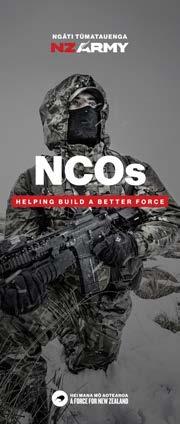
On reflection, I think the winner will be our Army as the application of their novel thinking is brought to life.
High calibre! In late October, a panel of General Staff members poured over the Army’s shortlisted candidates for SOTY 22. From a pool of many – came 13, and from 13 came just three NCO finalists. In the end, we were pleased to announce the overall 2022 winner as A/Sergeant Jack Colton, a medic with DHO, with our two runner ups – Corporal Jack Dowdle (QAMR) and Corporal Gabriel ‘Kielu’ Tapu (YDU).
Following on with an Army winning streak I’d also like congratulate Lance Corporal Jason Hart (2/4 RNZIR) who was named the 2022 NZDF Reservist of the Year, well done! To the units and staff who brought their work and efforts into recognition – thank you.
Power of One. Among the accolades and praise cited above, it’s hard not to comment on the many sole members and smallteam efforts operating all over the nation, region and world. I wanted to pass a final shout-out to that work and all of you out there.
So starting from our sporting divas in the recent Women’s International Defence Rugby competition, our intelligence and fusion analysts forward-deployed, the PNG Kokoda trail-walkers from NZSOF, Soldier Modernisation Office and capability team
Class Two Mike Marvin who was recognised with the New Zealand Bravery Medal (NZBM) for putting life and literally ‘his limbs’ at risk during a grenade training incident in June 2020. Ka mau te wehi!
In closing, as you read this last Army News for 2022 and prepare to close down for Christmas, the Chief of Army and I encourage you to pause and reflect on your successes throughout the year. For those who can, take some well-deserved leave to be with your friends and whānau – you earned it. Each of you are equally important to the collective achievements we share as an Army, and I thank you for Tū Tika – Commitment to serve as we remain an agile and ready force to respond to a persistently uncertain future.
We are Ngāti Tūmatauenga. Noho ora mai
WO1 Wiremu Moffitt 16th Sergeant Major of the Army
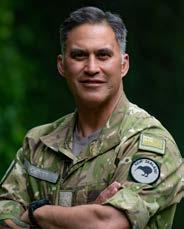
OP TIEKE
Commander Joint Forces New Zealand Rear Admiral Jim Gilmour said that with the extensions announced by the Government, NZDF personnel would continue to play their part in international efforts to support Ukraine’s self-defence against Russia’s invasion.
“The professionalism, dedication and commitment of our personnel has been recognised by our partners, and they’ll continue to work with purpose to have an impact on Ukraine’s ability to defend itself.”
An infantry training team of up to 66 NZDF personnel is to conduct training of Ukrainian Armed Forces soldiers, in the UK, with the deployment due to be completed by 31 July, 2023.
The deployment of up to 12 NZDF intelligence personnel in the UK, as well as the NZDF’s New Zealand-based open source intelligence staff, will be extended through to 30 June, 2023, and there will be two additional support positions in the UK.
Up to eight additional NZDF personnel will be deployed to command and support the NZDF
personnel based in Europe supporting Ukraine’s self-defence.
Logistics support will recommence with the deployment of four personnel to a logistics hub in Europe, until 30 June, 2023.
The deployment of NZDF personnel in liaison officer roles will also be extended through to 30 June, 2023.
There are currently 135 NZDF personnel deployed to the UK and Europe in support of Ukraine’s self-defence.
This includes 120 NZ Army personnel delivering training as part of the UK-led Operation Interflex, training Ukrainian recruits.
They are split into two training teams: Kiwi Team 1 made up of personnel from 1 Battalion, Royal New Zealand Infantry Regiment (RNZIR) based in Linton, and Kiwi Team 2 of Burnham-based 2/1 RNZIR personnel.
They are delivering a five-week Infantry Basic Combat Course designed to increase survivability and lethality on the battlefield.
The training is broken down into a basic introduction to soldiering, tactical exercises, range practices and live field
firing. It covers weapon handling, combat first aid, operational law, field-craft, offensive and defensive operations, and marksmanship.
The NZDF training teams are in their second rotation of training. The first group of more than 320 recruits trained by the New Zealanders have returned to Ukraine to defend their country. A second group, also of more than 320 recruits, are part-way through their training in the UK with the Kiwi teams.
Once they have completed their course, the Ukrainian soldiers either continue with specialised training in other roles with some likely to deploy on the battlefield.
Major Tom Kelly, the Senior National Officer of the NZ Army training teams in the UK, said they felt a deep sense of purpose and responsibility for the Armed Forces of Ukraine recruits, and were working tirelessly to deliver the training and prepare the Ukrainians for the fight that lay ahead.

The two infantry training teams are due to return to New Zealand in December. The main body of the third infantry training team will deploy in January, commencing training soon after arrival in the UK.
NZDF deployments in support of Ukraine have included a C-130 Hercules and air detachment, intelligence staff, liaison officers, logistics support to cohere and coordinate distribution of military aid, plus an artillery training team and the two infantry training teams instructing Ukrainian Armed Forces personnel.
The Army News is published for the Regular and Territorial Force and civilian staff of the New Zealand Army. Editor: Judith Martin Ph: 021 240 8578 E: armynews@nzdf.mil.nz www.army.mil.nz Printing: Bluestar, Petone. Design: Vanessa Edridge, DPA, NZDF Editorial contributions and letters are welcomed. They may be sent directly to Army News and do not need to be forwarded through normal command channels. Submit them to The Editor, Army News, DPA, HQ NZDF, Private Bag 39997, Wellington, or by email. Deadline instructions: Army News is published on the third Tuesday of each month, except January. Please have all contributions to the editor by the first of the month. Nothing in the Army News should be taken as overriding any New Zealand Defence Force regulation. Readers should refer to the relevant service publication before acting on any information given in this newspaper. ISSN 1170-4411 All material is copyright, and permission to reproduce must be sought from the editor. Cover: Ex Torokiki. Photo: Corporal Sean Spivey ISSUE 538 NOV/DEC 2022 NZDefenceForce NZArmy NEWS Ukraine assistance 02 Soldier of the Year 03 Reservist of the Year 05 PEOPLE Top medic 06 Bravery award 07 Bushfire medals 14 Army Innovation Awards 15 TRAINING Ex Torokiki 10 Ex Mountain Warrior 12 Ex Hari’i Hamutuk 13 Combat sappers 22 SPORT Basketball 25 Women's football 27 Men's football 28 Women's league 29 Women's rugby 30
SMA.NET To
A soldier greets Defence minister Peeni Henare who visited the New Zealand contingent in the United Kingdom.
me, October was a month for the non-commissioned and commissioned young officers of our Army.
New Zealand Defence Force deployments to the United Kingdom and Europe in support of Ukraine’s selfdefence will continue into 2023.
supporting Land Forces (Aust), and finally to Warrant Officer
“The New Zealand training teams have integrated seamlessly with the Ukrainian training audiences, the recruits having responded very well to the New Zealand soldiers and officers instructing them. The humility, dedication and professionalism our soldiers and officers display is being noticed and is having an impact on the battlefield.”
A MESSAGE FROM CHIEF OF ARMY
Despite all that we’ve been through over the last two years, and all of the challenges we’ve faced – individually and as an Army – our people continue to step up in ways that not only vindicates the equipment and training we provide, but clearly demonstrates that our officers and soldiers are quality.
Reflect on how impressive it was that the team from 2/1 RNZIR, representing Army at the recent UK Cambrian Patrol military skills exercise, won a gold medal. Many units that enter the competition do not finish, few reach the standard of a gold medal and, of those that do, it’s rare for one of them to be an international competitor. Yet, after two years of MIQ duty and limited training opportunities, the soldiers from 2/1 proved themselves to be amongst the best – outstanding.
Reflect on the efforts of our soldiers currently serving in the Sinai in the recently completed Multinational Force and Observers Shooting Competition.
Our contingent, drawn from representatives from across the Army, came first in the minor units and second against the major units with the US Infantry Battalion winning by only a small margin. One of the NZ contingent was awarded top shot.
And then there are the efforts of our members of the Defence Ferns rugby team who came runners up in the Women’s International Defence Rugby Competition, the recent announcement of SGT Jack Colton as the NZ Army Soldier of the Year, and the formal acknowledgement of the selfless bravery, through the announcement of the award of the NZ Bravery Medal, of WO2 Mike Marvin.
It’s only six months since we regrouped following Operation Protect and commenced, as I commented back in March, rebuilding the foundational environment that is so important to not only the capabilities we develop and maintain, but the sense of purpose and enjoyment we all get from serving.
At the absolute centre of that rebuild has, is, and always will be, our people. And when you are an Army where individuals can switch focus, target effort, and not only challenge themselves to be the best they can be but achieve the world class outcomes I’ve described above, then we continue to be in a pretty good space.
Ex Torokiki further confirmed this. In seven days of quality training the Torokiki participants clearly demonstrated that Army has reached a key stage in its regeneration and is well positioned, with work in a couple of key areas, to lift our aiming mark and increase the level and complexity of our training in 2023.
But that’s for next year. Right now, it’s time to kick back, relax, and enjoy – free from the demands of MIQ duty – our first ‘real Christmas’ since 2019. And you’ve earned it. You’ve earned it through the quite outstanding service you gave our nation during Operation Protect. You’ve earned it by quickly regrouping and refocusing on our core business. And you’ve earned it by embracing all the opportunities you’ve been presented over the last six months and by striving for excellence at all you do.
You are quality people and it’s an honour to serve alongside each and every one of you.
My final word though, is to the wider Army family. To those partners and dependants who have continued to support our officers and soldiers throughout 2022 –thank you. Your support has been incredible and we are, and will always be, appreciative of all of the great things you do.

Merry Christmas all – enjoy your break and all the best for 2023.
Major General John Boswell Chief of Army
SGT Colton, 28, always knew he wanted a career in medicine. His mother is a rural nurse in Martinborough, and she inspired him to become an Army medic.

He says he particularly enjoys being an instructor. “We go up and down the country delivering training, and it’s great to be able to impart knowledge to other medics so we can save as many lives as we can.”
The Soldier of the Year (SOTY) Award is presented annually to recognise soldiers and officers who pursue the journey of excellence, demonstrate professional and domain expertise, and who display the core characteristics of the New Zealand Army soldier.
SGT Colton’s citation said he had shown constant and unwavering devotion to delivering a superior performance in his role as an instructor and furthering the medic trade.
“He has been tireless in his dedication to delivering high quality training across the spectrum of NZ Army outputs. He has protected the force by training personnel deploying on Operation Protect, delivered tactical trauma care, first aid training at The Army Depot and high level medical training to health professionals across all three Services.
“SGT Colton has also been instrumental in the delivery of the new Defence Medical Treatment Protocols. In his advisory role
for the DMTP he supervised and coached his fellow medics to achieve annual competency requirements. This required significant investment in personal time. His commitment to achieve the mission set before him and refusal to retreat in the face of challenges has been an example to everyone in the Deployable Health Organisation.”
For his service, SGT Colton has been awarded a CDF commendation, RNZAMC Soldier of the Year, runner up DHO Person of the Year and promoted to acting Sergeant. He was also selected as the medic and flag orderly for the Anzac ceremonies in Gallipoli, Turkey.
Keeping well heading into 2023
The end of the year can be a fun and busy time. We hope you all take time to recharge, enjoy yourself and celebrate achievements.
It’s also a busy time when pressures, risks and stressors, can begin to build up at work and at home.
Our key message to you:
Spend some time doing things that you enjoy, whether that’s getting outside in the sun, going for a swim, spending time with loved ones, reading a book or even have a bit of time doing nothing!
Over the Christmas period it’s important to think about your own self-care. It’s also a time to keep an eye-out for friends and loved ones for whom Xmas may be a lonely or difficult time.
Like you, we want people to enjoy this time of year, have a good break and be back in good shape to start 2023, energised and happy.
Defence Heath have created a helpful resource with useful information on keeping ourselves and others safe and well.
It covers:
Support services for you and your whānau

• Financial Health – links to tools and resources
• Healthy relationships and consent – guidance and contacts for support and advice
• Tips and tools for keep yourself and others safe regarding alcohol and other substances
• Defence Health Hub – for tools and information to help us all thrive and perform at our best
Scan the QR code to get this helpful guide.

Share it with your team as we head towards the end of the year and upcoming break.
Remember – rest, relax, be proud of your achievements and enjoy a well-deserved break!
ARMY NEWS 03
Defence Health Organisation medic trainer Sergeant Jack Colton has been named Soldier of the Year for his tireless dedication in delivering high quality training across all three NZDF services.
SGT JACK COLTON SOLDIER OF THE YEAR
BURNHAM SOLDIERS WIN GOLD IN FAMED BRITISH ARMY PATROL CHALLENGE

For the first time in two years the New Zealand Army competing in the British Army exercise dubbed “the world’s toughest patrolling test”.
Eight soldiers from 2nd/1st Battalion, Royal New Zealand Infantry Regiment (RNZIR), based in Burnham, represented 1st New Zealand Brigade in Exercise Cambrian Patrol, competing against 97 other teams from around the world in the mountainous Brecon Beacons area in Wales.
Cambrian Patrol is the premier patrolling event of the British Army and hosted by Headquarters 160th (Welsh) Brigade. The aim of the exercise is to enhance operational capability within units.

Patrol Commander, Lieutenant Tony Calder-Steele, said the team had its military skills tested over an intense 48-hour period as they covered about 60km on foot.
The tasks varied from working in a Chemical, Biological, Radiological and Nuclear environment, dealing with explosive ordnance threats and battlefield casualty drills, through to reconnaissance tasks and even dealing with media.
The team prepared for the exercise for six weeks, focusing on pack fitness skills and any other skills that may be tested along the way.
Scottish-born Private Steven Higson was part of the patrol’s scout pair and was looking forward to the challenge.
“I was most looking forward to competing against other nations. Our training was well structured, having our Physical Instructors put us through personalised programmes, as well as others teaching and training us on specific topics in preparation for what we might encounter.”
2/1 RNZIR competed in Exercise Cambrian Patrols in 2018 and 2019 but due to the Covid-19 pandemic the unit was unable to compete in 2020 and 2021.
Lieutenant Calder-Steele said it was an exciting prospect to be able to have soldiers compete internationally again after spending so long on Operation Protect.
The team of 10 included eight soldiers, one Army Reserve Force soldier and a team manager.
NZ Army teams have won gold medals in the Cambrian Patrol in 2011 and 2015.
5/7 RNZIR Conducts Platoon Live Field Firing
 By 2LT J Corbett, 5/7 RNZIR
By 2LT J Corbett, 5/7 RNZIR
5/7 RNZIR’s unit focus is on mastering dismounted combat skillsets in the close country environment and Exercise Hindenburg Line was another opportunity to develop our craft.
East Coast Company, West Coast Company and Wellington Company together contributed two platoons of Reserve Force soldiers and junior officers to conduct a live field firing activity focusing on the tactics, techniques and procedures of the ambush.
Exercise Hindenburg Line is a culmination of several months of build-up training conducted across the Battalion with an emphasis on close country patrolling and section and platoon ambushing.
Soldiers deployed from their forward operating base at Helwan Camp to Ghost Bush, where the two platoons received lessons on the siting of key weapon systems including the Charge Directional Fragmentation (CDF), before rotating through dry runs of the activity.
Both soldiers and junior officers gained an understanding of how intelligence, surprise and weight of fire may be wielded effectively.
Intelligence was fed to the platoons by radio from a notional ISTAR attachment, giving the junior commanders situational awareness and information on the right time to strike.
Once the ambush was sprung, the platoons brought overwhelming firepower to bear on their targets, commencing with sequential CDF detonations and then engaging the killing zone with the LSW and the MARS-L.
“Senior NCOs and officers have always told me that ambushing is the most complex tasks for a platoon commander in the field. It wasn’t until completing my full mission appreciation process that I was able to fully appreciate all of the detailed considerations and the trained state required to spring an ambush successfully,” said Second Lieutenant Peter Havell, platoon commander who commanded two live ambushes during the exercise.
5/7 RNZIR is now pivoting to support reserve force individual coursing including RTFACB 167 MOD 2, TF Corps Training, TFCC 2023 before returning to close country blank and LFF training on Exercise Bapaume in February 2023.
If you are considering a transition out of the Regular Force, the Reserve Forces are always looking for soldiers and officers who still enjoy soldiering and want to continue service in a different way.
04 ARMY PEOPLE
A team of 2nd/1st Battalion, RNZIR soldiers won gold at the Exercise Cambrian patrol in Wales in October.
In the wake of winter’s last gasp dusting Ruapehu’s lower slopes, 5/7 RNZIR converged from the three corners of the lower North Island to conduct Exercise Hindenburg Line at Ghost Bush, Waiouru.
RESERVIST OF THE YEAR
The Reservist of the Year is awarded to a member of the Reserve Forces regardless of Service, trade, branch or rank, who best exemplifies the Defence Force values of Tū Kaha –Courage, Tū Tika – Commitment, Tū Tira – Comradeship, and Tū Māia – Integrity, in their service as a Reservist.
LCPL Hart is an outstanding performer within the NZDF Reserve Force and this has been recognised by his unit, 2nd/4th Battalion, (RNZIR) New Zealand Infantry Regiment. He has shown a high level of commitment to his Reserve

Force duties through his frequent attendance at Unit parades and activities, in spite of his busy schedule as a 3rd year medical student. LCPL Hart volunteers his time to support his Unit, planning and co-ordinating physical training sessions, and he is trusted to manage the armoury, while also volunteering to support local Cadet Units.
During the past two years, LCPL Hart’s Unit has undergone a period of significant and intense change. He has played a significant role in building a positive and inclusive culture within his Unit during this time.
In addition to his Reserve commitments, Lance Corporal Hart has identified a need within his community to support student learning. He has developed a local enterprise, Tutor4U to support student learning through pairing tutors with students in need to support.
Lance Corporal Hart is a reliable and committed member of 2/4 RNZIR. He is highly regarded for his efforts, conduct and performance by his Unit Command.
SPORTS AWARDS
SAFETY PERSON OF THE YEAR
A former Royal New Zealand Armoured Corps Warrant Officer, he is responsible for managing the 63,000ha training area, including the airspace. Adam consistently goes above and beyond his job description and shows a significant and ongoing commitment to improving safety across the vast area he covers.

He says most people who use the range are very safety conscious – “but some need reminding of a few things!”
Adam maintains full situational awareness to prevent any safety events from occurring. He regularly speaks up about issues and situations which may negatively impact the range, and is a strong leader with great communication skills, and is comfortable speaking openly to all levels of command. This includes occasionally challenging staff who require assistance in ensuring training is conducted safely and managing conflicting requests. He will have difficult conversations when necessary to ensure everyone gets home safely.
Adam often makes himself available after regular work hours, for tasks not reflected in his job
description. He recently assisted the NZ Police with rescuing an injured tramper when a helicopter rescue wasn’t a viable option, and walking to the tramper would have taken too long. Adam utilised NZDF vehicles to take Taupō search and rescue personnel to the camp boundary. The rescue was fast and efficient, and embodied the NZDF Values of Tū Tira – Comradeship and Tū Māia – Integrity.
Adam is proactive about safety. He looks out for NZDF personnel by making smart and important decisions before people are put at risk. His knowledge of general safe practice, NZDF safety policy, and NZ health and safety legislation is of a very high standard. He ensures all of Waiouru Range Control’s policies, procedures and communication methods are up to date, and was instrumental in designing new visitor induction briefs. He played a significant part in the roll out of new mobile devices for all range users. Additionally, in part thanks to Adam, all range users now have access to a GPS tracking system. This allows users to have two way contact with range control, and have their location recorded if they need help in an emergency.
Super heavyweight boxer Lance Corporal Uila Mau’u has won the NZDF Outstanding Sportsperson Award.

LCPL Mau’u won a number of national amateur boxing awards in 2019 including New Zealand Super Heavyweight gold medal. Earlier this year he competed in the Maco Nena Challenge Belt, an Oceanic International Competition, winning the 92kg category. He has met the International Olympic Committee qualifying criteria and was selected for the New Zealand 2022 Birmingham Commonwealth Games where he earned a bronze medal.
WO1 Cross has been involved in NZDF netball for 30 years, She was first selected for the Combined services netball team in 1990, and has held various play and official appointments in Army and NZDF sport. She is the code chair for NZDF netball, and has also made a considerable contribution to Touch rugby. Major Whitton has had a long and involved commitment to volleyball.
 The 2022 New Zealand Defence Force Reservist of the Year Award winner is Lance Corporal Jason Hart.
The 2022 New Zealand Defence Force Reservist of the Year Award winner is Lance Corporal Jason Hart.
Waiouru Military Training Area Range
Manager Adam Hoffman has been named Safety Person of the Year, and was the Safety nominee for NZDF Person of the Year. He is also the winner of the Safety Excellence Award for 2022.
Army netball stalwart Warrant Officer Class One Wai Cross and Major Glen Whitton have been awarded NZDF Colours for their commitment to sport.
ARMY TAKES OUT TOP MEDIC AWARD AT MEDIC MATCH 22
Fifteen medics from the New Zealand Army (NZ Army), Royal New Zealand Navy (RNZN) and Royal New Zealand Air Force (RNZAF) fought it out for the title of ‘top medic’ recently and the NZ Army took out the top spot.

The tri-service competition is designed to find the best all round medic and includes physical endurance activity, shooting, advanced medical skills, cognitive problem-solving and public speaking.
First place was taken out by NZ Army Staff Sergeant Andrew Kennedy.
“The Medic Match competition has been a great physical and mental challenge. The event really pushed the body and mind to its limits. It was truly an honour to compete alongside such an awesome calibre of tri-service medics, in our unrelenting pursuit of excellence,” says SSGT Kennedy.
All the medics were competing for the first time and experience ranged from recent graduates of the Defence Health School, who will have just met the full medic competency requirements, through to medics who have spent more than 15 years in the field.



“The competition is designed to find the best all round medic, there’s something to challenge everyone from any service. Whether it’s a physical endurance activity, shooting, advanced medical skills, cognitive problems, public speaking or just turning up with the right kit.
Competitors need resilience, trade skills, and technical excellence to win,” says Medic Match 22 co-ordinator, Lieutenant (LT) Aidan Bilbe, Assistant Training Officer Deployable Health Organisation.
On day one, the medics are tested for resilience at the shooting range at Auckland’s Tamaki Leadership Centre, followed by a ‘Rescue Randy’ scenario; dragging an 80kg casualty over 75 metres and applying a tourniquet and pressure bandage. Core skills are focused on in day two of the competition, with competitors completing a swim rescue and resuscitation at Devonport Naval Base. Four medics made it through to the third and final day, with clinical and technical excellence the ultimate test, contested at RNZAF Base Auckland, Whenuapai.
“The participants were very impressive this year and the top spots were hotly contested. It’s the first time the biennial challenge has been spread across more than one day, and the challenges were carefully designed so that they don’t favour one service or another,” says LT Bilbe.
Traditionally held in the Manawatū, this year’s competition was based in Auckland, at Tamaki Leadership Centre, Devonport Naval Base and RNZAF Base Auckland, Whenuapai.
NZ Army medic Lance Corporal William Wallace took out second place and RNZAF medic Leading Aircraftman Scott Endres came in third place.
06 ARMY TRAINING
Competition SSGT Kennedy at work.
Top, and above, a contestant mid-task.
SOLDIER WHO SAVED COLLEAGUE FROM GRENADE BLAST RECEIVES NZ BRAVERY MEDAL
A Linton-based soldier who tackled a junior colleague out of the way of a grenade blast following a misthrow has been recognised with the New Zealand Bravery Medal.
Acting Warrant Officer Class
Two (WO2) Mike Marvin was the safety supervisor during a grenade throwing practice at the New Zealand Defence Force Raumai Range in June 2020.
During the practice, to re-qualify soldiers on using hand grenades, the younger soldier removed the pin and took a throwing stance but misthrew the grenade, which missed the natural safety rise and landed dangerously close.
Realising immediately what had happened, WO2 Marvin tackled the soldier backwards into a small depression four metres from the grenade, using his body to shield them from the blast.
He said his training kicked in immediately.
“Safety instructors are trained what do when there is a misthrow. We often practise a dropped grenade scenario, although the real thing had never happened to me before.”
The grenade exploded but WO2 Marvin didn’t realise he had been injured until about 15 minutes later.
“At the time we were all concentrating on the soldier I took down as they were in a lot of pain because I landed on them.
“Someone asked me if I was OK and I lifted up my top and saw I was bleeding.”
He received fragmentation blast injuries. Eight steel balls from the grenade are still in his lower body as they are too deep to be removed.
However, he said he wasn’t in much pain and has had no after-effects.
The former British Army soldier who has been in the New Zealand Army for 14 years and is a Master Driver for 1 (NZ) Brigade, said he was grateful for the safety training he has received.

“I suppose there was a bit of luck in it too, but training certainly pays off.”
No blame could be attributed to the soldier, he said.
“It was just a one-in-a-million incident – it just went wrong.”
ARMY TRAINING 07
“
Safety instructors are trained what do when there is a misthrow. We often practise a dropped grenade scenario, although the real thing had never happened to me before.”
HELPING UKRAINIANS FIGHT AND SURVIVE
1st Battalion, Royal New Zealand Infantry
Since August, 1st Battalion soldiers and officers have been deployed to the Salisbury Plains, in England as part of Kiwi 1 Training Team, delivering training to the Armed Forces of Ukraine to enhance their survivability and lethality on the battlefield.

The training programme allows little time for rest. From the moment the Ukrainians are extracted from the battlefield and flown across Europe to the Salisbury Plains they are gripped up by their Kiwi counterparts and put through their paces. Whether it is receiving lessons on the Laws of Armed Conflict or battle handling exercises assaulting trenches by day and night as a section, K1 trainers are delivering the basic infantry combat skills required to survive the realities of close combat operations in the Donbas Region.
For the most part learning how to use weapons comes naturally to the Ukrainians, the majority having handled various weapon systems before, and they pick the lessons up quickly. Knowing that time is precious, the trainers maximise every opportunity to enable the Ukrainians to become better fighters, better soldiers, to
help them survive on the battlefield, and win the war. This requires significant flexibility and initiative at all levels and is a constant challenge to ensure training is tailored to the training audience.
The majority of learning is done in the field environment, where no effort is spared, no shortcuts are taken, and no easy ride is given.
Despite the Ukrainian soldiers having had experience on the battlefield, K1 trainers demonstrate daily what is required to be a professional soldier, which is quickly replicated. This is to ensure that the next time the Ukrainians use the lessons they have been taught, these will be executed to perfection on the battlefield in the defence of their homeland. Hence, the soldiers and officers from K1 find ways to make training more challenging and realistic, to drive excellence and make them that little bit harder to kill and that little bit better at taking the fight to their enemy.
The K1 team and members of 1st Battalion will return home soon. Before they leave the UK, they will have made some friends for life. Their commitment, dedication and professionalism has been recognised by their Ukrainian
and British counterparts. They will return to New Zealand in time for the Christmas break knowing that they have represented their country, the NZ Army, their families and themselves to the highest standard expected of them. To the wider Task Group and members of 2nd/1st Battalion, Defence Health Organisation, 2nd Engineer Regiment and HQ JFNZ, it has been a privilege.
Onward.
08 ARMY MISSION
Who wants to train Ukrainians to defend their homeland? Soldiers and officers of
Regiment, have been working hard to increase the Ukrainians' military skills
NZDF to experiment with loitering munition technology
However, they are capable of being equipped with a variety of payloads, including an explosive warhead. Its camera means it can be also used for reconnaissance and surveillance tasks.
Loitering munitions are small, uncrewed aircraft systems (UAS) with an on board weapon payload.
The UAS are operated remotely, and as the name suggests they are able to loiter above the battlefield until they either precisely engage a target or are ditched in a safe area.
The NZDF will conduct initial experimentation with the Australian-made Defendtex Drone 40, which are about 12cm long, weigh 190gm, and can fly 15km for approximately 20–60 minutes.

The experimentation will initially involve inert payloads so the devices can be re-used.
The Drone 40 can be used against light vehicles, small boats and adversaries. The operator makes the decision to select and engage targets, remaining in control throughout. Loitering munitions also have the ability to be ‘waved off’ from a target should the situation change, unlike traditional munitions which cannot be controlled once fired. This capability has the potential to both increase weapon precision and significantly reduce collateral damage concerns.
Both the New Zealand Army and Royal New Zealand Navy will be involved in the experimentation, said Major Oliver Lynn, Joint Fires Capability Manager.
“Loitering munitions reduce the risk of NZDF personnel being unnecessarily exposed to direct

fire, and allows the NZDF to identify and engage targets with precision” he said.
“This is a rapidly evolving capability, and is already under evaluation and in service with our traditional partners. It is also currently being employed effectively on the battlefield in Ukraine.
“It is important for the NZDF to understand this capability, both for its potential for future use within the NZDF, and to recognise how to best keep our people safe against adversaries who may use such munitions against us on future operations.
“There are likely to be wider opportunities in the future to experiment with this type of capability, including experimentation with live loitering munitions. This is the first step, and no decisions have been made to progress any integration of this technology into service at this point in time,” Major Lynn said.
The exercise was about Special Operations interoperability, with a focus on Special Reconnaissance in the littoral and extreme cold weather environments.

One of the personnel involved was LCPL H.
“My role in the exercise was a patrol 2IC. The exercise was full on, in the first week we focused on training and utilising cutting edge technological means to support our operations. After this I led a patrol task conducting demolitions, before stand-off diving onto a beach in the Hauraki Gulf to provide observation, informing the OC’s plan to conduct a Special
Recovery Operation. The main body approached the target via RHIB, before conducting a night time foot approach on to the compound of interest, recovering the sensitive target and exfiltrating in one period of darkness.
“We then travelled to Tekapo where we conducted extreme cold weather activities and long range high angle shooting in the Southern Alps.
“This was some awesome patrol and squadron NZSAS training.”
For more information on how to join LCPL H, visit the NZSOF ILP or nzdf.mil.nz/ nzsas
ARMY EXERCISE 09
The New Zealand Defence Force (NZDF) is to experiment with loitering munition technology as it looks to keep pace with the changing character of conflict and do the utmost to keep its personnel effective and safe on contemporary operations.
Exercise Silver Sabre Trident was a multinational FVEY Special Operations Forces activity conducted in August and September. It involved personnel from US, Australia and 1 NZSAS Regt.
TE ARANGA AKE O TŪ
THE RE-EMERGING OF NGĀTI TŪ
By Charlene Williamson
In late November more than 1,000 soldiers from around the country descended on the Manawatū Region for a major milestone activity that would set the conditions of regeneration for the New Zealand Army.

Exercise Torokiki is the largest single activity that the Army has conducted in the last two and a half years, following Operation Protect and support to the largest domestic operation in living memory as part of the All-of-Government response to Covid-19.
It is the first time this generation of soldiers had taken a deliberate pause to reconnect with the culture of Ngāti Tū.
Land Component Commander Colonel Duncan Roy said the exercise has reconnected personnel with the core combat skills demanded of the New Zealand soldier.

“While these skills are basic, they are the foundation of what it is to be a soldier in the New Zealand Army.
“Training of this type is part of our core business as soldiers and the skills gained allow us, as an Army, to be able to build into more complex challenging war fighting,” he said.
Torokiki means to sprout afresh, re-emerge and re-establish and this includes the evolution of the Army’s culture and the fundamental foundations of Ngāti Tūmatauenga.
The exercise started with a culture phase which refreshed
soldiers on key aspects of the Way of the New Zealand Warrior, a re-invigoration of the NZ Army Haka, continued learning on Ngāti Tūmatauenga, and its evolution within the Profession of Arms.
People and Culture Warrant Officer, Army General Staff, Warrant Officer Class One (WO1) Ray Kareko said it is important for soldiers to understand the unique culture of the Army.
“Our people are at the heart of our culture. Ngāti Tūmatauenga is strengthened by our bicultural whakapapa, and it is vital in shaping and enhancing the performance of our organisation. Our culture underpins every aspect of how we operate and it provides us with the framework that everyone can adhere to.
“Culture enables us to define the way our people should behave. When we hold true to our culture we operate with mana, we respect ourselves and our teams. We are Ngāti Tūmatauenga,” WO1 Kareko said.
Significant work has been undertaken by NZ Army Marae staff to understand what Ngāti Tūmatauenga means to the organisation. This work coupled
with stories from Te Ao Māori, and NZ Army whakapapa gives understanding, belonging, connection, and being able to identify with Ngāti Tūmatauenga.
The culture day ended with a rousing haka by all soldiers at the exercise.
The core individual skills of shoot, move, communicate and medicate were exercised through a number of high-tempo activities including a longest day activity and a Close Combat Shooting Package at Raumai Range with the MARS-L rifle.
Chief of Staff, 1st New Zealand Brigade, Lieutenant Colonel (LTCOL) Brett Stott said the longest day gave soldiers the opportunity to re-connect with core military skills, underpinned with camaraderie competition and a hint of fun.
While this longest day wasn’t the traditional “day of pain” it did include purely physical tests like the gun run, as well as watermanship which tested teamwork, co-operation and the ability to operate in water.
“A soldier must be good at the all core basic skills of move, shoot, communicate and medicate to
enable the application of trade and rank-based competency.
“The longest day skillset is applicable to all ranks and trades, regardless of experience or ability. Activities were based around the platoon groups, and gave leaders a chance to lead teams throughout the day and apply competencies in a controlled, yet challenging environment,” he said.
All set in Linton Military Camp, the activities tested soldiers' mental and physical endurance through the application of core military skills like teamwork, weapon handling, orders and medical care.
“Each activity was designed to bring out specific skills and the sequence of activities over each day with regulated physical and mental exertion,” LTCOL Stott said.
Commanding Officer, New Zealand Collective Training Centre (NZCTC), LTCOL Jacob Murray said the Close Combat Shooting Package (CCSP) at Raumai Range provided soldiers with a live field firing activity.
“Consistent shooting is a fundamental training objective for all personnel. Soldiers must conduct live firing training regularly to ensure their individual

competence and confidence is high before they take part in collective and, eventually combined arms training as part of Army’s regeneration,” he said.
The CCSP at Raumai Range provided a high tempo and dynamic training environment where shooting proficiencies were developed building a solid base for individuals to progress in their training.
“Coupled with this, soldiers also completed an airmobile activity where they trained with No.3 Squadron in emplane and deplane procedures with the NH90 helicopters. This provided the opportunity to plan and conduct troop lifts with a large number of personnel.”

LTCOL Murray said the skills of shooting competency, weapons safety, weapon handing in a live firing environment, understanding of marksmanship principals and peer coaching within pairs and small groups all progress skills and confidence of the NZ Army soldier.
“In addition, exposure to a field firing environment is a progression from shooting on a purpose-built range with added complexity in safety application and terrain,” LTCOL Murray said.

Capability demonstrations were on display by Network Enabled Army (NEA) and the Soldier Modernisation Office. This included interactive presentations on the new soldier personal protective equipment, soldier load carrier equipment and the soldier modular sleep system.
There was an emphasis on simulation which gave soldiers a chance to utilise the latest tools under evaluation by Training and Doctrine’s (TRADOC), Technology Enhanced Learning - Army (TEL-A) project. These interactive demonstrations have set the scene for what is being worked on, and what will be on offer in the years to come.
Commander TRADOC, Colonel (COL) Trevor Walker said the simulation displays showcased the different systems that are available to soldiers for training.
“These systems are designed to enhance training and provide a combat orientated introduction to modernised learning.
“Technology Enhanced Leaning is a key part of contemporary learning methods, and these concepts are widely understood and experienced by new recruits entering our organisation,” he said.
Urban Operations, Call for Fire procedural training, the Mantis marksmanship trainer, virtual shooting, land experimentation and weapons and training simulation systems displays all provided soldiers with the opportunities to try these technologies hands-on.
COL Walker said new training and technology will help to move Army training into the future.
“We are in a unique position within Army to provide units with the exposure to safe and realistic training using TEL-A, and give them an appreciation of future training concepts which will enhance the way we train our soldiers,” COL Walker said.
When effectively integrated into Army training, both simulation and TEL are key enablers to support part-task and procedural training through to scalable, full immersion training events.

The week concluded with a family-friendly concert where the New Zealand Army Band and New Zealand drum and base act Shapeshifter performed.
“The past two years has been tough on all aspects of the New Zealand Army,” COL Roy said.
“Our journey to regeneration will not be about re-creating the Army that existed before the pandemic, it is about having an Army that is better trained and prepared to meet complex security challenges in an increasingly competitive and contested global environment.”
Exercise Torokiki was the first deliberate milestone activity in the New Zealand Army’s regeneration journey, and is just the start of a long-term plan over the next five years.

“Training of this type is part of our core business as soldiers and the skills gained allows us, as an Army, to be able to build into more complex challenging war fighting.”
Acting Land Component Commander Colonel Duncan Roy
OPEN COUNTRY SKILLS ON MOUNTAIN WARRIOR
This exercise is a culmination of 16-weeks of training for Combat Corps trainees and provided an opportunity for them to demonstrate the knowledge, skills and attitudes required to perform as a member of a rifle section within combat units.
Officer Commanding Major (MAJ) Josh Ritchie, PV-M Squadron, Queen Alexandra’s Mounted Rifles said throughout the exercise trainees demonstrated that they could not only survive, but also thrive in adverse and unpredictable conditions.
“The exercise was designed to simulate real world combat operations as close as possible.
“Students completed a series of complex and arduous battlefield tasks, by both day and night, and in a range of conditions,” he said.
Trainees were exposed to a variety of tasks and were tested on a number of abilities, including attacking simulated enemy forces, digging defensive positions, gathering information on enemy forces, and defending terrain from attacks.
“We train to develop the skills, knowledge and attitudes needed to succeed on operations.
“This training ensures that when soldiers do find themselves in potentially dangerous situations, either domestically or overseas, they will be equipped with the experience and training needed to succeed,” MAJ Ritchie said.
Soldiers were tested on a number of skills including navigation, radio procedures, weapons knowledge, casualty care, fieldcraft, tactical movement, and understanding open country tactics.

The exercise concluded with a section live field firing element, where rifles, machine guns and grenades were used to destroy a simulated defending enemy force.

In support of the exercise NZLAV and Royal New Zealand Air Force NH90 helicopters were also used.
MAJ Richie said this exercise was three months in the making, both in terms of exercise preparation and teaching.
“Considerable effort was placed into ensuring that the training was conducted safely, and the battlefield conditions were replicated to be as realistic as possible.
“All the skills used on this exercise are considered the very basics required to operate as a member of a rifle section within a combat unit. Every combat soldier is expected to master and refresh their knowledge of these areas throughout their career.”

Having completed this exercise our newest Combat Corps soldiers have demonstrated what is required obtain the converted red diamond qualification badge, worn on the Army ceremonial dress uniform.
“It is an accomplishment that they should all be justifiably proud of.”
By Charlene Williamson
12 ARMY EXERCISE
Mastering the skills required of every combat soldier have been tested for our newest infantry and armoured soldiers on Exercise Mountain Warrior in Waiouru.
EXERCISE HARI’I HAMUTUK 22 –TIMOR LESTE
By Corporal Michelle Patterson
Exercise Hari’i Hamutuk
local tetun language is an annual multilateral exercise.
This involves Australian Defence Force (ADF), United States Navy, United States Marine Corps, Japanese Ground Self Defence Force, New Zealand Defence Force (NZDF) and Forcas de Defesa De Timor-Leste (F-FDTL), and is conducted over seven weeks in Timor Leste.


The main focus for the exercise is to exchange and enhance trade skills with F-FDTL in support of their defence capability and trade knowledge. The NZDF deployed four personnel - two combat drivers and two maintenance fitters. Although our team was small among other nations, we left a lasting impression with not only our students but our partnering nations with hopes for NZDF to continue contributing to this exercise annually and bringing more overseas opportunities to our trades.
The exercise began with an opening ceremony in Metinaro Military Base and at the conclusion we met our students for the first
time. The Transport Mentor Training Team (MTT) was made up of a sergeant, a corporal, six privates and a naval officer interpreter with whom we worked very closely due to the language barrier. We taught basic maintenance, recovery, driving skills, how to write and deliver orders for administrative and tactical road movement, tactical resupply missions, and convoy discipline.
Both the transport and welding teams spent the majority if not all of our training time outside under purpose built hangars or training areas where escaping the heat was near impossible. Although the F-FDTL aren’t equipped with much in terms of vehicle equipment or expendables, which made a lot of lessons difficult to teach, it’s evident that they make do and work with what they have and they get the job done no matter how long it takes, a testament to their ingenuity and resilience.
Over our seven weeks we had the privilege of travelling five hours south to Suai with our
two permanently posted NZDF Headquarters elements, LTCOL Jonathon Fiu and WO2 Rawhiti Turia with the help of our interpreter Fransisco de Araujo.
Fransisco was attached as an interpreter to both blue and green patrols throughout the NZ Batts while the NZDF was deployed to East Timor from 1999 - 2002 to restore peace and security sanctioned by the United Nations after East Timor declared independence from Indonesia.

Our four day trip saw us travelling through the beautiful villages of the Suai district, visiting historical sites and the once-operating FOBs in the area. We had the honour of visiting and paying our respects at the memorial sites of WO2 Tony Michael Walser RNZIR, PTE Leonard William Manning RNZIR, and the privilege of restoring the memorial sites of SGT Rakabu, RFMFOC and PTE Pedar O Fleatharta 8th Irish Contingent UNTAET. We all left Suai with an increased knowledge and understanding of the hardships and loss all nations faced in the name of peace.
Hari’i Hamutuk concluded with a closing ceremony attended by ambassadors and delegates from each contributing nation who congratulated all members involved in the successful running of the exercise.
Overall my experience was enjoyable, trying to find innovative ways to teach our students with the bare minimum of equipment. Becoming very good at charades due to the language barrier, was not only challenging and demanded a lot of patience but in the end very rewarding. Seeing how far our students had come from when we first met them to when we departed was a reward in itself and we left Metinaro Military Base knowing we had made a small difference in the way they’ll conduct future working days. We hope to build upon these skills for future exercises.
An immense thank you to LTCOL Fiu, WO2 Turia, their partners and families as well as the ADF who hosted our small contingent throughout, and made us feel welcome at our home away from home. Your hospitality and generosity was thoroughly appreciated and one day we hope to repay the favour. To our new friends from all other nations and walks of life, we hope to see you again soon. Obrigada
which means ‘build together’ in the
ABCANZ meeting aids cohesion and integration
The Deputy Chief of Army Brigadier Rose King hosted the American, British, Canadian, Australian, and New Zealand Armies Programme (ABCANZ) Executive Council Meeting from 14–16 November.
ABCANZ is the primary FVEYs land medium for interoperability. The programme aims to improve interoperability, leverage training opportunities and inform modernization. This is critical to the NZ Army regeneration efforts, and its ability to retain its world class, multi-role combat forces that are of such high utility across the spectrum of operations. For the New Zealand Defence Force it was a key international defence engagement for 2022.
The meeting for the first time included amongst its attendees three female Deputy Chiefs of Army – BRIG King, Lieutenant-General Sharon Nesmith of the UK Army, and Major General Natasha Fox of the Australian Army.
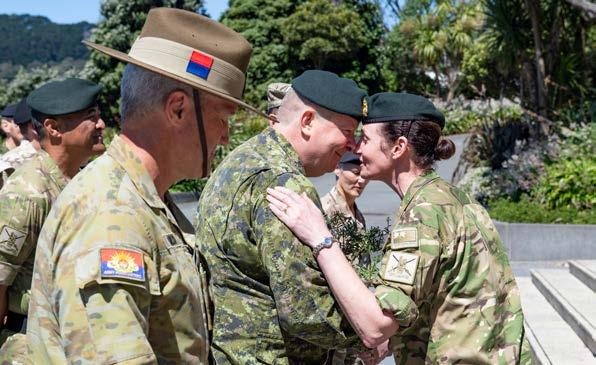
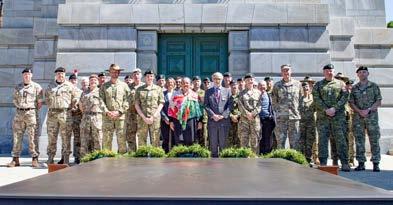
The Council meeting began with a pōwhiri and wreath laying ceremony at Pukeahu National War Memorial. The unique character
of Ngāti Tūmatauenga was highlighted further with the Deputy Chiefs visiting Army’s home and marae in Waiouru.
The Council supported the NZ Army’s efforts to achieve interchangeability with its ally Australia which will be an effective and efficient method of improving interoperability with other ABCANZ partners.
The meeting allowed for robust and detailed discussions on the challenges of modern land warfare and the minimum requirements for land combat systems; in the NZ Army’s case its Motorised Infantry Battle Group and for others their Brigade Combat Teams, Divisions and Corps. It demonstrated the criticality of the NZ Army’s Networked Enabled Army, Protected Mobility and Fires modernisation projects.
It also allowed ABCANZ partners
to explain the outcomes of their recent experimentation based on lessons from the Ukraine and predictions regarding future threats. This included their future requirements for un-crewed aerial systems, counter un-crewed aerial systems and air defence, precision fires, and the need for ubiquitous anti-armour, protected mobility, robotics, sensors and night fighting equipment at Battle Group and Combat Team levels to be survivable in modern operations.
The Council explored the operational and organisational benefits of having common equipment and reduced supply chain vulnerabilities as a means of speeding up operational integration.
Overall, the ABCANZ Executive Council Meeting reinforced NZ Army analysis and decisions to reinvigorate alignment with
AUSTRALIA RECOGNISES
NZDF PERSONNEL FOR BUSHFIRES RESPONSE
Australian High Commissioner Harinder Sidhu has presented medals to a number of New Zealand Defence Force (NZDF) personnel in recognition of their service during the 2019/20 Australian Bushfires.
More than 170 NZDF personnel, as part of Operation Bushfire Assist 2019/20, travelled to four states in Australia to help during the intense bushfire season known as the ‘Black Summer’.
The deployment included NZDF firefighters, combat engineers, air dispatchers, enviro health teams, a primary health care team and a chaplain, along with assets including a C-130H(NZ) Hercules and crew, and three NH90 helicopters and crew.
The NZDF played a varied role in supporting the Australian authorities and the Australian Defence Force.

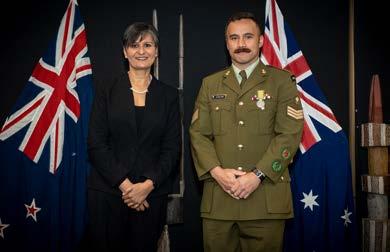
Chief of Defence Force Air Marshal Kevin Short said the NZDF could be proud of the way its people displayed their commitment to Australian communities during a devastating and highly volatile time.
“Their actions have reinforced the value of our close relationship with Australia”.
Overall, 145 NZDF personnel received the Australian National Emergency Medal, among them New Zealand Army Emergency Responder, Sergeant Joshua Nahi.
His time as an emergency responder has taken him to a range of domestic and international emergencies including the Christchurch earthquake, Tasmanian and Queensland fires, Port Hills, Pigeon Valley, and the 2019/20 Australian Bushfires.
Direct fire suppression, hazard reduction burning, and maintaining overnight patrol teams at the fire-line, were just a few of the tasks Sergeant Nahi and his team undertook.
“During fire suppression, your body is fuelled by adrenaline and purpose to knock the fire down,” said Sergeant Nahi.
However, fire-fighting was not the most demanding task, he said.
“The most challenging part during all of this was the physical demand of mopping up.”
This involved removing any burning materials, felling firedamaged trees, and cooling ash pits to ensure the fire was extinguished and reduce any residual smoke.
“A firefighter can fight as long as the fire is present, but it’s followed by hours or even days of digging up hotspots and blacking out large portions of land to ensure the fire is properly extinguished,” Sergeant Nahi said.
the Australian Army and the reconstitution of doctrinal naming conventions for the NZ Army’s platforms. This will improve the cohesion of capability, training and readiness plans.
Ultimately, this ensures that the NZ Army is more interoperable
Although not having direct experience with animals hurt by the bushfires, Sergeant Nahi knew this was an emotionally challenging aspect faced by some of his colleagues.
The acknowledgement Sergeant Nahi and his team received from their Australian counterparts was what made the extreme physical demands worth it, he said.
“Despite many hours or days mopping up, the most rewarding part was the genuine appreciation the Queensland Fire and Emergency Services showed. Appreciation also
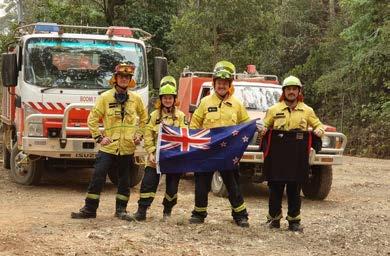
came from the local residents and the general population.”
Helping local communities hit by devastating natural disasters was what motivates Sergeant Nahi to put himself at risk for others.
“I enjoyed every minute of it. This is why I’m a firefighter. Helping others is what we do.”
14 ARMY PEOPLE
with our ABCANZ ally and partners and is able to provide highly effective, multi-role Land Forces ready to meet the needs of the NZ Government.
DCA, BRIG Rose King greets one of the attendees.
Australian High Commissioner Harinder Sidhu and Sergeant Joshua Nahi.
IDEAS THAT WORK
THE ARMY INNOVATION CHALLENGE
ADHD often have advantages in terms of energy, creativity and big picture thinking. People with autism can be more rational, less susceptible to group think, and possess better memory recall.”
LT Gradwell said an NZDF neurodiversity strategy could look at how it could make use of the advantages, and what changes were needed to harness the benefits of conditions like ADHD and autism.
He received a Porohita and Pikorua pounamu taonga, two SMA coins, and an Army Innovation coin.
Private Matthew Nelson was first runner-up in the Army Innovation challenge with his proposal to digitise the LPF38 to enable data driven insights on soldier performance.
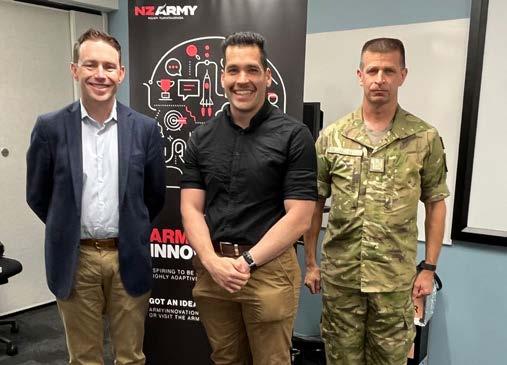



would help us develop the next generation of army leadership. Performance data would become more accessible to the individual soldiers that are being reported on, commanders who lead them, all the way up to senior leadership teams that make strategic decisions. There are also a lot of ad-hoc reports that you could generate from the data.
PTE Nelson received a Manaia pounamu taonga, an SMA boxed set coin, and an Army innovation coin.
Major David Pos won the Environmental Sustainability category with his proposal to use defence land to promote carbon neutrality. “My submission had been percolating for many years in my brain before I committed it to print,” says Major Pos.
This year Lieutenant Jack Gradwell won the Army Innovation Challenge with his idea that the NZDF establish a neurodiversity strategy. A member of the Royal New Zealand Army Education Corps, and based at the NZ Defence College, LT Gradwell’s proposal encourages the NZDF to see the value in having greater emphasis on neurodiversity across its ranks.
He said his entry in the Innovation Challenge was broadly about people “who don’t fit the mould”.
“Most people will, knowingly or unknowingly know a soldier with ADHD or autism.
“In the case of ADHD they will often be seen as disruptive, with poor time management skills. In the case of autism they are often seen as weird, bad cultural fits, argumentative of stubborn. However, both conditions offer serious advantages. People with
The LPF38 (Command Notebook – Observation Form) is how the Army conducts performance reporting on junior soldiers (PTE-LCPL) who do not fall under the PDR framework. The form itself captures quantitative data across a range of competencies and qualitative observations by commanders; unfortunately the current process sees the document printed and filed, resulting in the organisation losing its ability to interrogate the data and draw insights into its soldiers at an individual or organisational level.
PTE Nelson said the key benefit of his proposal would be allowing junior soldiers to better understand how they are performing over time, and how they can develop.
“In their formative years, soldiers are (theoretically) at their most malleable. The ability to highlight development opportunities and monitor performance over time
“I have always been interested in being able to make a difference at the individual level, and to feel in control of how I cover the carbon emission “debt” that comes from my service in the NZ Army. Between doing volunteer tree planting with Te Ara Kakariki and studying sustainability in great depth in my Masters study, I felt now was the right time to make a suggestion on how we, as individuals, support initiatives from higher to make a difference in reducing the NZ Army’s carbon emissions.”
He believes this is important for a number of reasons. “Aside from our obligations as a government department, it is the right thing to do. We are kaitiaki of NZ, both as protectors of the land in the military sense, but also as custodians of our own land. We are compelled to take the lead and empower our soldiers to take ownership of their carbon emissions and give
them some tools to minimise the impact that their service has on the environment.
“The soldiers of today, and those of tomorrow who have not yet even been recruited, will demand it of the organisation. If we want to attract and retain the best and brightest, we must demonstrate an honest and genuine desire to improve what we are currently doing.
“We have the personnel and most of the resources already with which we can achieve a meaningful impact. The key resource we need now is greater education. Education on where we can make small meaningful changes at unit level and below, and how to get the best ‘bang for buck’ with those changes. Partnership with local businesses, iwi, community groups and the like who focus on these kind of activities will be essential in developing and growing our own knowledge base and enhancing the NZ Army’s ability to empower its people to make these changes.”
Major Pos was presented with a toki pounamu taonga, an Army coin, and an Army innovation coin. Civilian Mike Evans won the Business Excellence category. Mike’s proposal is based on how the Army accounts for its stores. Using a custom-built information tool in DDMS to track NZDF assets he believes significant savings can be made. A prototype tool has led to a more than 60 percent improvement in inventory KPIs, and significant efficiency gains. Mike wants to concept endorsed so it can be developed further.
Other proposals that reached the finals in the Innovation Challenge ranged from one that involved identifying linguists throughout the NZDF, an amnesty for NZDF-owned items, and further support to NZDF sporting activities.

Army personnel have always been innovative, and the Army 2022 Innovation Challenge has shown that creativity and strategic thinking is alive and well across all ranks.
Colonel Justin Dyhrberg (left) and Warrant Officer Class One Andrew Boykett with finalist LT Phillip Luke.
Finalist PTE Matthew Nelson.
Army Innovation winner LT Jack Gradwell.
The winner of the environmental sustainability category Major David Pos.
Our people
RIP ALAN HOFFMAN
Mr Hoffman, 64, died after a lengthy illness.
The funeral was very emotional at times, but also funny and insightful as it detailed both his extensive military service with RNZAC and also what he had been up to when he retired from the Army in 1996 and went on to make a name as one of New Zealand’s leading kayaker administrators. He was a keen paddler on the national white water kayaking scene.
As a soldier he epitomised what it was to be a professional and earned the lasting respect of both officers and soldiers who served with him. He was awarded a Chief of General Staff’s Commendation in the early 1990s for his tireless work to establish the Limited Services Volunteers programme in Burnham Camp. Because he had a brother serving in the same unit at the time, Alan was always known as ‘Big Hoff’ in the RNZAC.
Given the nickname ‘Sarge’ by the kayaking community, Alan influenced several generations of kayakers, and was the driving force in building a world class white water slalom course in Tekapo in the last 5 years of his life. Even when he was sick from the numerous ‘Chemo’ rounds he had, he would still head to Tekapo to keep the construction programme on track, doing most of the physical work himself.
QAMR SSM WO1 Shannon Brears RNZAC led the RNZAC funeral party that supported the service and the Regimental Colonel for the RNZAC, COL Hamish Gibbons (J3 at Headquarters Joint Forces New Zealand (HQJFNZ) was in attendance. Amongst mourners were a number of present and former members of the corps and
many friends and family. Many more joined the service by live stream.
The NZLAV (adorned with BIGHOFF number plates) carried him on its ramp slowly to the chapel and he was carried into the chapel by RNZAC Warrant Officer and SNCO pall bearers who had been trained, probably disciplined and lead by him.

At the end of the service, Alan was carried by family members back to NZLAV and his funeral procession route was lined by many kayakers who raised their paddles in a final salute while the SNCOs who knew him from the unit, carried him back onto the NZLAV for his final journey. A fitting tribute to a well loved husband, dad, friend, soldier, kayaker and leader who made a difference.
Reserve Force doctor clocks up air miles and experience
As a young medical student, Louise Speedy joined the New Zealand Army Reserve Force just for something to do. Twenty-six years later that decision means she has been able to travel everywhere from Afghanistan to Hawaii, and closer to home.
Major Speedy, 45, from Hawke’s Bay, was one of the team which took part in a specialist teambuilding activity at Whanganui Hospital this month, drawing together Regular Force and Reserve Force clinical specialists from New Zealand Defence Force (NZDF) Health.
Personnel, who usually operate in different hospital settings, worked as a team to complete some elective surgical procedures on adult patients at Te Whatu Ora, Whanganui.

It was the most recent activity for the anaesthetist and intensive care specialist. Major Speedy has been deployed on many different operations with the NZDF, including the Rim of the Pacific Exercise (RIMPAC) in Hawaii earlier this year.
Every summer through medical school she was involved in Reserve
Force activities. When she became a junior doctor she got a bit more serious and she deployed to Afghanistan.
It was a juggle to fit it all in, and Major Speedy said it was a matter of trying to maintain the good will of colleagues
juggled shifts while she was away, as well as having a supportive husband and children who thought it was cool what she did.
While fitting everything in might be a juggle, Major Speedy said it was the people that kept her doing what she was doing.
SERVING NZ FOR CLOSE TO HALF A CENTURY
By Charlene Williamson
After nearly 47 years in uniform Keni Joyce, MSM, is handing in his boots and heading off shore to spend time with his children and grandchildren on the Sunshine Coast.
Staff Sergeant (SSGT) Joyce enlisted into the New Zealand Army Territorial Force as a rifleman in November 1975 and served with 3rd Auckland and Northland Battalion for six years. In January 1981, at the age of 26 he enlisted into the Regular Force of the Army where he has served for the past 41 years.
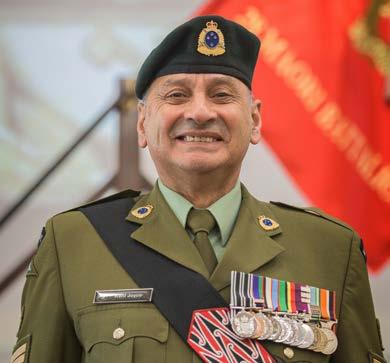
SSGT Joyce initially intended on joining the Regular Force as a rifleman but back then he was considered too old, so he became a Combat Driver.
Learning his trade on the old RL Bedford, he said the truck was reliable and “ran on the smell of an oily rag”.
“When I attended course at the School of Trucks and Cakes they taught us about extemporisation and improvisation which made these vehicles so easy to fix.
“I recall many times while driving in Malaysia, particularly on long hills, where the Bedford was slow. You would find a logging truck would overtake you on the right, at the same time you would look out your left window to find another logging truck overtaking you on the grass verge. It was mind blowing and something I will always remember,” he said.
SSGT Joyce has driven all the long and short wheel based Land Rover Series of vehicles the Army has had in service, including the V8 model, and all the forklift models.
In 1985, on promotion to Lance Corporal, SSGT Joyce was posted to Singapore as the section second in command of New Zealand Transport Squadron and said this has been his most enjoyable posting.
“I was very lucky to have an accompanied posting with my wife and two young sons where we were
able to experience some pretty amazing things while we were there.
“I was the section second in command, but I spent most of my time volunteering for tasks in the Malaysian Jungle where 1st Battalion conducted exercises and lots of infantry courses that I was eager to participate in.”
In his time in uniform SSGT Joyce has been deployed to Sinai in 1991 and 2017, East Timor in 2002 and 2010 and Afghanistan in 2005. In addition he has deployed five times to Antarctica in support of Operation Antarctica, one of NZDF’s longest running deployments.
SSGT Joyce holds the Long Service and Good Conduct Medal with clasps one, two and three. In March 2013 he was one of the last personnel in the NZDF to be awarded The New Zealand Meritorious Service Medal (MSM) before it was replaced by The New Zealand Defence Meritorious Service Medal in November 2013. The MSM was awarded to members of Defence above the rank of Sergeant who had served at least 21 years and hold their service’s Long Service and Good Conduct Medal. There are currently only ten serving Army soldiers who hold the MSM.
SSGT Joyce said the Army has changed dramatically since he joined however it still provides soldiers with skills for life.
“The Army has educated me and given me skills that I can apply in everyday life. What I have learnt in my time is that teamwork will always overcome individualism.
“I will miss the camaraderie and friendships I have developed over the years, but I am also looking forward to retiring and spending quality time with my grandchildren,” he said.
Reverting back to Staff Sergeant on posting from Warrant Office Class One, the last eight years of his career he has been the Logistics Co-ordinator at the Southern Regional Support Centre.
16 ARMY PEOPLE
Hundreds turned out in Rangiora for former RSM, QAMR WO1 (Rtd) Alan Hoffman’s funeral recently, and the unit plus officers, troops and an NZLAV guided him onwards.
“I get to work with people in both Regular and Reserve Force units. There are some awesome people in Defence and I love the different dynamic with Defence Force patients too. I was part of a three-person team in my hospital tasked with setting up our Covid-19 Intensive Care Unit in three weeks.
“The skill to do those kinds of things is part of my Defence Force training, such as the critical thinking and the way you analyse problems.”
who
CHALLENGING ENVIRONMENT, MAXIMUM REWARD
By Charlene Williamson
The New Zealand Defence Force has been contributing to the United Nations (UN) oldest peacekeeping mission, United Nations Truce Supervision Organisation (UNTSO), since 1954 providing up to eight military observers in monitoring roles based in the Golan Heights, Lebanon and Syria.
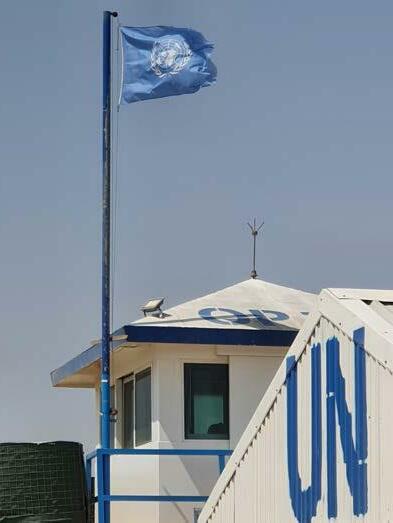
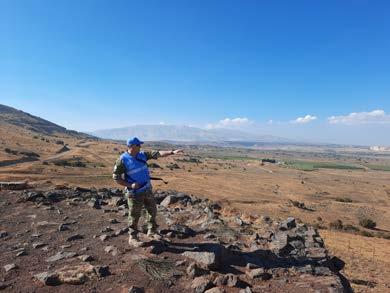
CAPT McEwan said he has always wanted to deploy to the Middle East so when the opportunity came he took a short term regular force engagement.
“The mission seemed very interesting, particularly Syria where the Civil War has been going on since 2011 and has had a significant effect on UN operations in that country.”
Deployed for 12 months, CAPT McEwan spent the majority of his time as a UN Military Observer in the Northern part of the UNTSO operational area, but had a challenging role in the latter part of his deployment as a Team Leader for a newly stood up team in the Southern part.
“The Southern part had the highest threat risk and was a very complex operating environment due to the ongoing effects of the civil war in the area.
“My role was to stand up the team, provide input into operational development, and work with UN
Disengagement Observer Force on integrating local security force elements.
“It was very challenging, but also very rewarding,” he said.
A Reserve Officer since 2017 and business owner in his day-to-day life, CAPT McEwan said being able to utilise his skills from his day job definitely helped.
“Having a strong knowledge of legal documents and legal systems helped a lot. It is a complicated environment with many different layers of agreements governing how the mission operates.
“As well as that, the UN has a large number of local and international civilian staff and has operating structures that are both military and non-military. So knowing both sides of military and civilian organisational structures definitely helped in the roles I did,” he said.
The effects of Covid-19 were challenging on this deployment CAPT McEwan said.
“The mission itself was affected by ongoing Covid-19 related operating protocols, including whenever exposed or travelling between borders.
“Government and UN mission rules in the countries we were operating in changed regularly which increased complexity in
Tā Wira Gardiner officially farewelled
The passing of one of Māoridom’s most respected figures, Tā Wira Gardiner
A commemoration was held at Wellington Cathedral of St Paul and was attended by people from the many worlds Tā Wira walked in, including the Chief of Army Major General John Boswell and Sergeant Major of the Army, Warrant Officer Class I Wiremu Moffit, representing the New Zealand Defence Force.
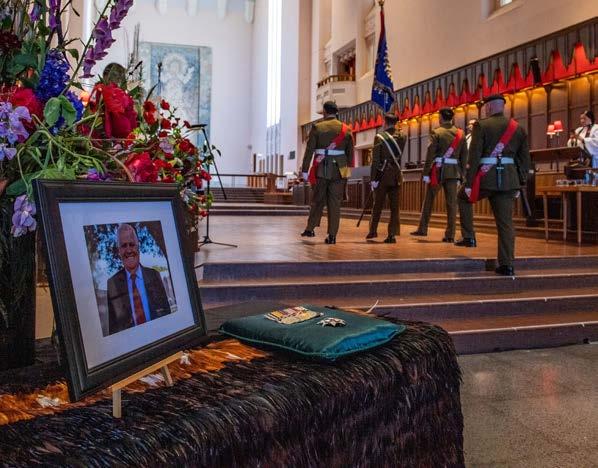
During his 20 years in the New Zealand Army, Tā Wira served in the Vietnam War as a platoon commander and rose to the rank of Lieutenant Colonel.
In recognition of Tā Wira’s service and contribution to the Army, a Colour Party from the 1st Battalion Royal New Zealand Infantry Regiment paraded the Battalion’s Regimental Colour carrying the Theatre Honour “Vietnam”. This was supported by the New Zealand Army Band, with Senior Sergeant Kevin Hickman also playing the “Last Post” and “Reveille”.
Tā Wira authored seven books, including two on the history of the 28 (Maori) Battalion and ‘A Soldier’s
View of the Vietnam War’ – told from the perspective of soldiers from Victor 4 Company.
After his military service, he went on to become a highly regarded public servant. He was the first Director of the Waitangi Tribunal, the first CEO of the Ministry of Māori Development – Te Puni Kōkiri, and also National Director of Civil Defence.
In 2009, he was made a Knight of the New Zealand Order of Merit for his contribution and services to Māori.
Tā Wira (Ngāti Awa, Ngāti Pikiao, Whakatōhea, Te Whānau-ā-Apanui) died in March, at the age of 78.
It was his wish that no tangihanga be held for him at that time, in order to protect people from the spread of Covid-19 and prioritise the demands on frontline health workers.
planning operations.”
However he said that working somewhere completely different to his normal world was something he enjoyed.
“Working with other countries militaries, being challenged, growing as a military commander, and travelling in the Middle East during short leave breaks were all highlights for me.”
The year-long mission involved working with around 40 officers from 19 other countries, and while the length of the mission is a long time CAPT McEwan said it was worth it.
“It is a complex mission and it takes at least four months to develop a high level of knowledge of the operational requirements of the role and the area of operation. It doesn’t make sense to leave just after you get to a point where you can add value to the mission.
“New Zealanders contribute well on this mission, not only to the UN operations, but also the ongoing enhancement of our military and national reputation internationally.
“I enjoyed immensely being in a very complex environment in Syria, and would absolutely do it again.”
ARMY PEOPLE 17
The complexity of the operating environment and growing as a commander were key highlights for Reserve Officer Captain (CAPT) Duncan McEwan on his recent deployment on Operation SCORIA.
was marked in Wellington on November 16.
CADET UPDATE
LCPL Moore’s unit took part in the recent National Army Cadet Skills Competition in Waiouru.

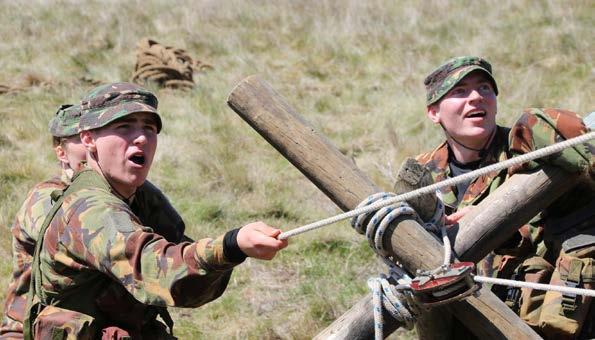
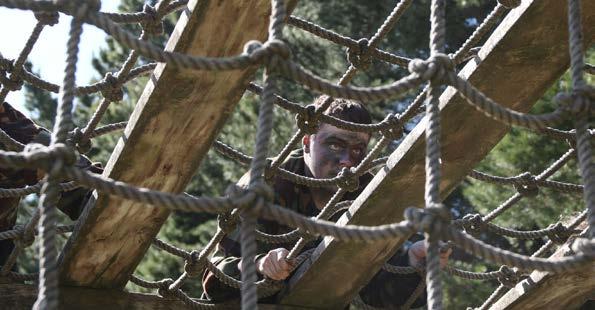

The Heretaunga College student has been a cadet for just under two years.
“When my friend joined (Cadets), we went with her on her third night and I loved it right away, mostly because my first night was CASEVAC and that meant I got to experience a very stressful situation and was thrown in to talk to everyone about what was going on. It was a little nerve-wracking when I was told to yell at the Corporal to stay awake during her “concussion”.
LCPL Moore says she has enjoyed meeting other people who enjoy the same thing as she does. “I’ve built great connections with other people and learned a lot about first aid which helped future CASEVAC situations. I’ve been taught discipline and order and it’s great being in an environment where everyone is well-mannered and all work together as a team.”
She says being a has helped her communication and leadership skills, and helped her gain the
confidence to be in her school’s Pride Council and use her skills in workplace experiences and Te Reo Maori school trips.
“Now I’m not just a follower, and I feel confident enough to take charge in stressful situations and help others in a team. So many leadership roles were offered to me, and I didn’t hesitate to take them.”
She joined cadets with her brother. “I haven’t had any extracurricular activities in years and my brother and I were just bored constantly, Cadets gave me something to do that isn’t just about learning but being able to get my hands stuck in for real life situations preparing us for the future.”
LCPL Moore enjoys painting and writing in her free time.
The highlight of her time in cadets so far? “The people! I have met so many like-minded people all across the central area, and with regional competitions I’ve been able to meet so many different people that I share so much with, from Army units all through to Air. I have made so many friends.”
Wāhine Wānanga –the value of engaging
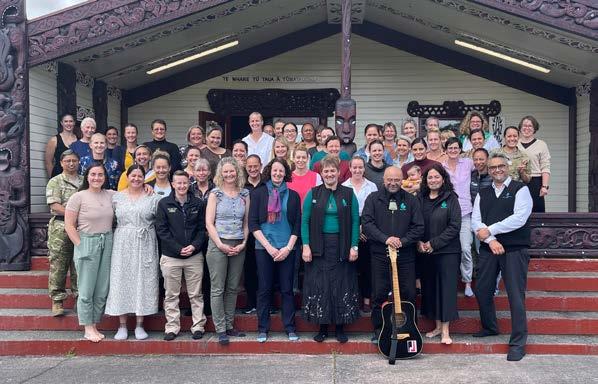
Deputy Chief of Army, Brigadier Rose King said the wānanga for wāhine at Rongomaraeroa o ngā hau e whā was valuable on many levels.
“I was reminded of the unique privilege our marae offers us as an environment that engenders a safe place for sharing, learning, openly challenging without judgement, and being able to bring the whole ‘you’. I have much to learn of Te Ao Māori, but with an open and curious mind-set I continue to learn of its richness and strengths and how we can all benefit from them. I encourage you all to do the same. This is the first in a series of wānanga where our wāhine and tane at all levels will have opportunities to engage in this important conversation.”
In
February issue of
the “what”.
18 ARMY PEOPLE
Senior officers and soldiers from throughout the Army gathered in Waiouru recently for the Wāhine Wānanga.
the
Army News Lieutenant Colonel Sheree Alexander writes about cultural competence – the importance of understanding the “why” not just
Being part of a cadet unit is like being part of a big family, says Upper Hutt 15-year-old LCPL Naomi Moore.
ELECTRICAL JACK OF ALL TRADES
By Charlene Williamson
Corporal (CPL) Braden Botica, from 3rd Workshop Company, 3rd Combat Service Support Battalion based at Burnham Military Camp says he knew post-secondary school he wanted a job that used his hands.
“I enjoyed working with electronics and completed an electrical pre-trade course. I enjoyed completing work experience throughout my pre-trade course, and this solidified my trade selection in the Army.”
Enlisting in 2014 CPL Botica wasn’t sure if the military was the right choice for him, but eight years later he continues to enjoy it.
Electrical fitters are charged with fixing anything, anywhere, in particular looking after power generation and reticulation as well as refrigeration systems. Safety is top priority; our fitters complete safety inspections for all operational Army equipment.
As a the electrical fitter team leader in Burnham CPL Botica says an average day is spent motivating and mentoring a team of ten to repair and maintain the Army’s low voltage electrical equipment.
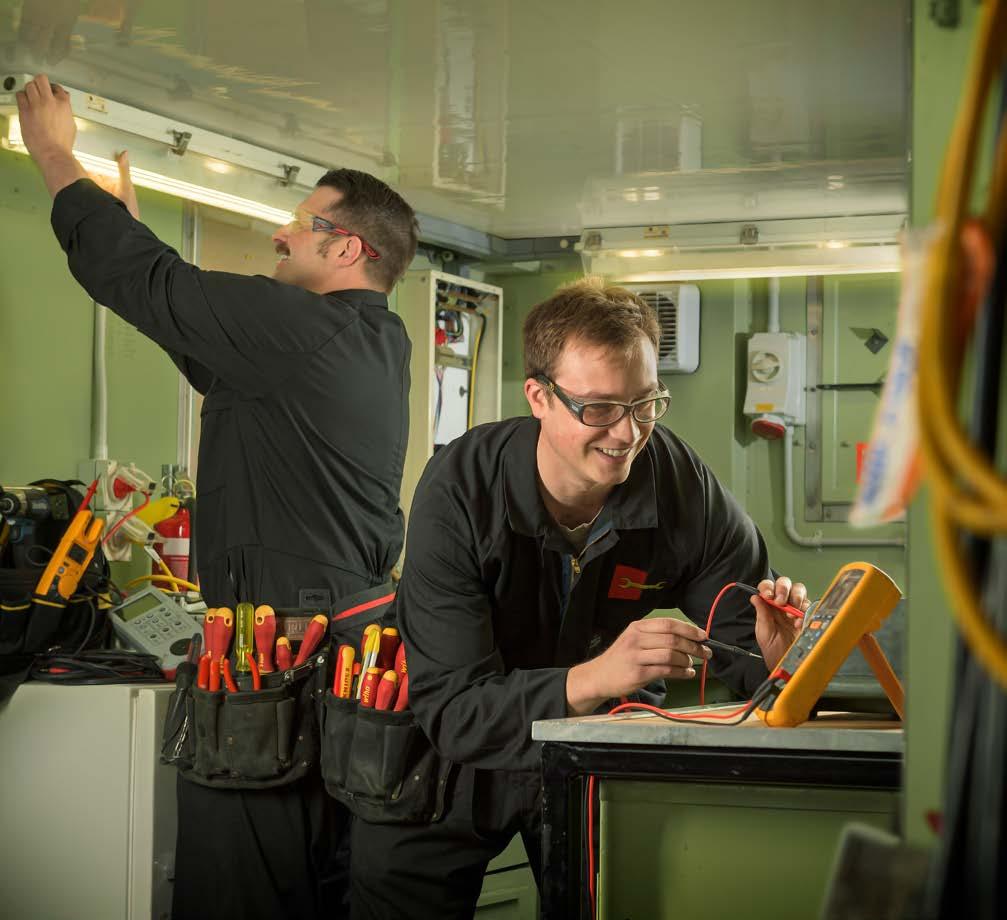
“As a team leader in the electrical space, my favourite thing is seeing young apprentices evolve into capable electricians that thrive into well-rounded individuals.
“The challenge of modelling my team into their better selves has shaped me into the person I am today,” he said.
Training for an apprentice Electrical Fitter in the Army will last approximately four years as you work towards an NZQA New Zealand Certificate in Electrical Engineering Theory and Practice (Trade) Level 4, and then onto full registration with the Electrical Workers Registration Board,eventually working towards a New Zealand Certificate in Electrical Engineering.
CPL Botica said anyone wanting to join as an electrical fitter in the Army should expect variety day-to-day, a well-paid trade, and the opportunity to grow as a person.
“Team members get to complete four months’ work experience stints in a variety of electrical fields, enrol at Universal College of Learning (UCOL), and undergo trade-training within and outside the workplace.
“In addition there will be various leadership courses, as well as being involved in activities that contribute to the welfare of New Zealand,” he said.
Electrical fitters will provide support to units in field exercises including the provision of maintenance support, including any other times when the Army is needed to support our local communities.
“The 2016 Kaikōura earthquake was my introduction to the role that Army plays in a natural disaster.
“A team of three - myself, an engineer and a medic walked 10km daily visiting residents, checking on welfare and the structural integrity of buildings.
“This task was humbling and has made a lasting impression on the importance of the Army during times of crisis,” CPL Botica said.
He will soon deploying overseas as an Electrical Team leader where he will be responsible for the repair and maintenance of electrical equipment at the Multi-National Force and Observers Sinai, Egypt.
For more information about joining as an Electrical Fitter in the NZ Army visit: defencecareers.mil.nz
ARMY PEOPLE 19
“The challenge of modelling my team into their better selves has shaped me into the person I am today.”
Known as the ‘jack of all trades’ amongst electrical workers, electrical fitters maintain and repair the vast array of electrical equipment used by the Army.
CAREER MANAGEMENT CORNER
PDR Career Plan Tab
Do you want more say in how your career develops? If so, have you completed the Career Plan ‘tab’ on your PDR? The Career Plan ‘tab’ is the place where you can have your say on your development goals, desired career progression or preferred roles, list any external experiences outside the NZDF you may have gained and any personal considerations you want to make your Career Manager aware of. Unfortunately, a large percentage of officers and soldiers don’t take the time to fill it out.
Your completed PDR Career Plan ‘tab’ will be essential to inform the 2023 Career Board of your thoughts on how you would like your career to develop. If you don’t fill it in, then the Board will be unable to take your desires into account when assessing your potential and development required.
Completion dates for the PDR are
1 Up End of Year comments completed – NLT 29 Nov 22 2Up End of year comments completed – NLT 13 Dec 22 Member closes off the PDR – NLT 20 Dec 22
2023 Career Boards
The 2023 Career Board dates have now been released. The Career boards confirm promotion gradings, extension of engagements and, starting in 2023, will see the Officer SCMB/CMB and soldier WOEB focus on providing more detailed development guidance to individuals. The following officers and soldiers are considered at the Career Boards:
Soldiers – All SSGTs to WO1.
Officers – Capts O/3 and above. All other officers and soldiers (CPL–SGT and 2LT–CAPT O/2) career decisions are made at the Unit level and Corps Development Advisory Boards.
MILITARY JUSTICE ONLINE
The New Zealand Defence Force has now published its Annual Report on the Military Justice System on its website.

The move is in line with the Defence Force’s policy around transparency and informing the public of its processes.
New Zealand’s military justice system is a separate and parallel system of justice that forms an integral part of the New Zealand legal system. It also shares many of the same underlying principles as the civilian criminal justice system.
The report details data collected on judicial cases over the 2021/22 financial year. During that period a total of 426 Summary Trials (dealing with 590 offences) were heard. There were five appeals to the Summary Appeal Court.
Four trials were heard in the Court Martial of New Zealand and there were two appeals to the Court Martial Appeals Court.
Chief of Defence Force Air Marshal (AM) Kevin Short welcomed the move to make the information public.
“Publishing the report is integral in ensuring our systems and processes are transparent to the public.
“We hold our people to a high standard and publishing the report on the NZDF website shows we are effective in holding the actions of our people to account, should they behave in a manner contradictory to military rules and regulations,” AM Short said.
Alongside public transparency, making the report public will also have a deterrent effect on personnel, making it clear that certain actions have defined consequences, he said.
The military justice system currently has a two-tiered structure comprised of a summary system and the Court Martial of New Zealand.
Information about Summary Trials and Court Martials, along with appeal decisions are included in the report. Summary Trial information is categorised by service, rank and gender. The types of offences tried are also listed.
Punishments imposed by Summary Trial and Court Martial are also detailed in the report.
The military justice system is designed to promote the operational effectiveness of the New Zealand Armed Forces by contributing to the maintenance of discipline, efficiency, and morale, while ensuring that justice is administrated fairly and with respect to the rule of law. These objectives give rise to many of the substantive and procedural differences that distinguish the military justice system from the civilian justice system.
The report can be found at nzdf.mil.nz/military-justice-report
The Career Management Review Project is starting to implement changes to the Career Management System and the DACM Operating Model. This will see a number of changes to how career management is delivered across the Army over 2023. If you want to see what these changes are go to the Career Management tab on the NZ Army ILP Command Post site and look for the Army Career Management Review link under Announcements.
Key
Officer Selection Board including the additional Commissioned from the Ranks Board. 12 Dec 22
Officer Career Interviews (various locations) 24 Jan – 3 Feb 23 Soldier Career Interviews (Wellington units) 7 – 16 Feb 23 Officer FPAB 7 – 17 Feb 23 Soldier Career Interviews (Linton units) 22 – 24 Feb 23 SCMB & SWOAB 24 Jan
20 ARMY NEWS
2.
1.
Dates 27 Nov-1 Dec 22
NZ Army Posting Date 24 – 27 Jan 23
– 10 Mar 23 Soldier Career Interviews 7 – 9 Mar 23 Officer CMB 17 - 26 Apr 23 Soldier FPAB 10 - 11 May 23 WOEB
more information:
Career
Site:
Contact us
For
Army
Management Intranet
http://orgs/sites/armint/I-0001/
at: DACMRegistry@nzdf.mil.nz
RE-OPENING OF NGĀ URI Ā TŪ
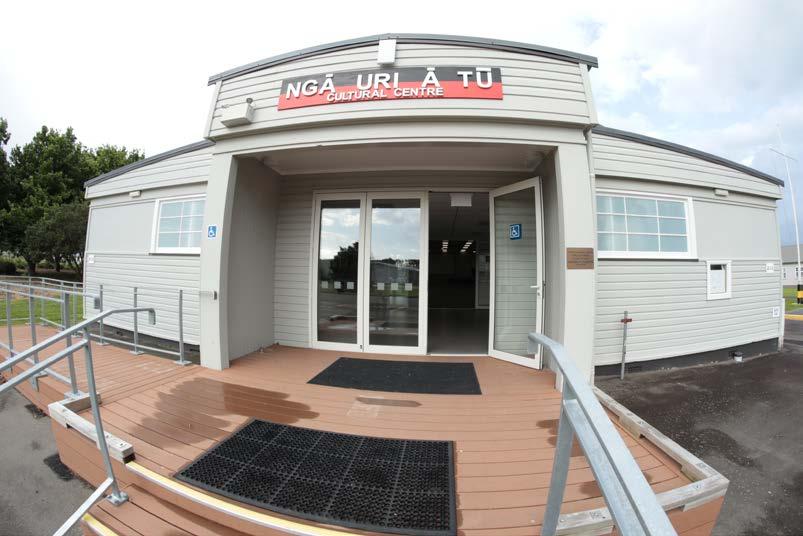
LINTON CAMP CULTURAL CENTRE
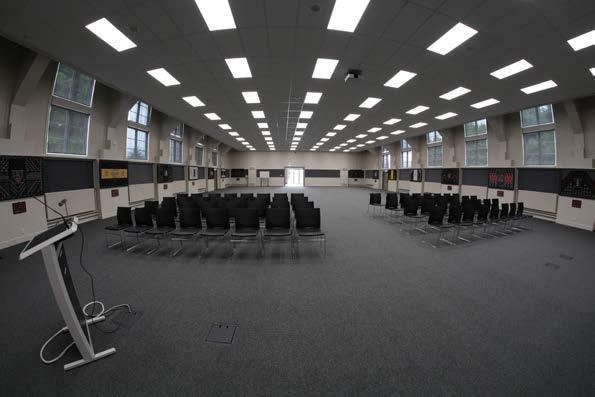
After a significant period of refurbishment, Ngā Uri ā Tū (Linton Camp Cultural Centre) was re-opened recently with a ceremony to re-bless all 15 tukutuku panels which represent units from 1 (NZ) Bde, TRADOC, JSG, NZDC, RS(A) and other NZDF civilian support providers.
Also included was the community tukutuku panel which represents NZDF partners and families. The ceremony was hosted by Commander 1 (NZ) Bde, COL Ben Bagley and Command Sergeant Major 1 (NZ) Bde, WO1 Lyall Mooney. It was attended by Mana Whenua, Mr Wiremu and Mrs Trieste Te Awe Awe, the Mayor Grant Smith of Palmerston North and unit representatives from Linton Military Camp.
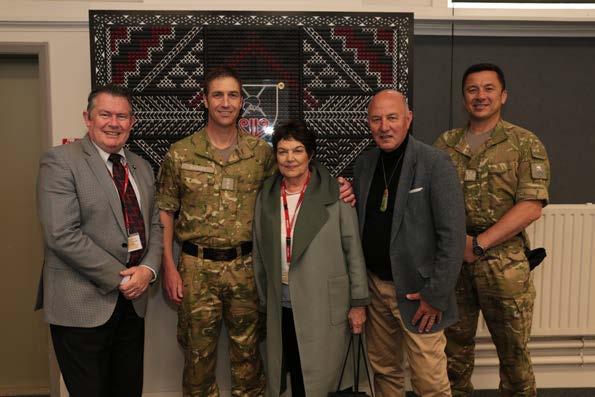
MAJ Andy Olivier (DEI Linton) spoke to the significant work completed on the facility which was once a Cinema, then Conference Centre and now Cultural Centre. The building was overdue for a re-fresh in keeping with the organisation’s needs. Overall the building has had the entrance way upgraded for wheelchair access, a refresh of the kitchen so that food and drinks can be prepared and served, and an upgrade of the ablutions. The building was then seismically strengthened with an upgraded fire system, new lighting, acoustic ceiling tiles, new carpet, new wall coverings, painted and a new roof. Thank you to Spotless and Lee Builders for your amazing work to upgrade and improve this facility.
MAJ John Cook (LRSC) presented a concept called “Wānanga Wednesdays”. The concept will see Wednesday afternoons prioritised for cultural training in Te Ao Māori including
Te Reo Māori, Kapa Haka and Mau Rākau. Te Reo Māori will be based on Scotty Morrison’s book “Māori Made Easy”, Kapa haka will be based on items from the NZDF Te Waharoa App which includes the NZ Army and NZ Defence Force Haka, and Mau Rākau which will be based on “Te Whare Tū Taua o Aotearoa” an innovative programme in the use of the taiaha founded by Sir Pita Sharples. Military and Civilian staff will be able to attend these training sessions which will be conducted next year as eight week training courses during February/March, May/June and August/September.
In the future the external structure will be developed as well as adjacent areas, establishing a carved entranceway and a reflection area. To ensure alignment with the development of Ngāti Tū, this initiative will be overseen by staff from the NZ Army Marae in Waiouru. Ngā Uri ā Tū is an easily accessible venue and to most personnel of the Land Component located in Linton Military Camp. Information will be sent out soon to promote the pilot course to be conducted in February/March 2023. We look forward to delivering these programmes to develop Ngāti Tū culture within Linton Military Camp and honouring our commitment to Te Tiriti o Waitangi.
ARMY NEWS 21
CDR 1Bde Colonel Ben Bagley (second left) Mayor Grant Smith (left) Mr and Mrs Te Awe Awe and RSM, WO1 Lyall Mooney.
RESF SAPPERS POLISH SKILLS
By Sergeant Caroline Williams
The course covered demolitions, military search and watermanship (military boating).
Combat engineers provide mobility, counter-mobility and survivability on the battlefield. This includes the creation or removal of obstacles using explosives, and using specialist equipment to conduct route clearance and search occupied/ unoccupied buildings.
Traditionally the BCE ResF course has been run alongside the BCE Regular Force (RF) course. This year the course was conducted as a stand-alone ResF course. Instructed predominantly by qualified ResF personnel delivering specialised instructional packages, this was a bespoke training package specifically tailored to ResF soldiers.
“From analysis of previous courses we were able to provide more focus in areas that required additional instruction for our ResF students. The training delivered by the instructors was of a very high level and was a great opportunity to contribute a Reserve Force solution
How to transfer to the ResF?
Members who are cleared to transfer to the ResF on release from the RF can choose to transfer to either the Ready Reserve (RR) or the Standby Reserve (SBR).
What is the RR and your obligations?
The RR are those reservists who are posted to a ResF infantry battalion or an integrated unit in 1 (NZ) Bde, TRADOC or JSG, and who regularly attend training. The RR contributes to Army operational outputs.
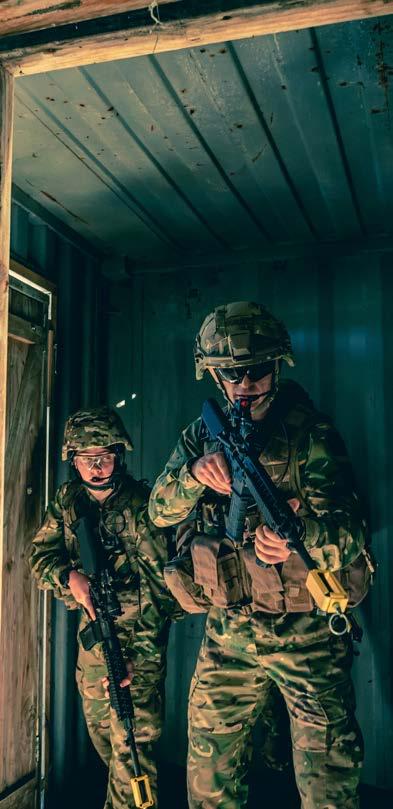
In the RR you are expected to commit to 20 days training per year (work and family commitments dependent), which will generally be one weekend per month, as well as the occasional weekday evening. You will retain your military kit except those items deemed as returnable IAW NZP23 Chap1 Sect 7.
What is the SBR and your obligations?
If you want to stay engaged with Army, but can’t commit to the RR, then you can ask to be posted to the SBR.
You will receive an offer of service for two years, with no requirement to attend any training.
to a Reserve Force problem,” said CAPT David Arnup, ResF 2IC 2Fd Sqn.
The main challenge in running the course lay with the boating phase. With a limited number of qualified instructors available army wide and the ResF having only one instructor throughout, the Regular Force (RF) instructors from 2 Engineer Regiment and the School of Military Engineering were required to conduct this phase alongside the available ResF instructor and staff.
“The support from the additional instructors was critical to the success of the watermanship phase, and ensured the students had sufficient exposure and instruction, subsequently achieving a high level of competence. It also showed the value of the integration of RF and ResF, particularly at the staff and instructor level,” said CAPT Arnup.
The watermanship phase began with classroom instruction, capsize and recovery drills in the pool, followed by a day at Dudding Lake learning practical skills such as
This allows you a period of time to settle into civilian life. At any time you can ask to transfer to the RR or the RF. You will be required to hand back your military kit, with the exception of Scale Army 107 IAW NZP23 Chap1 Sect 7 and your ID Card. The SBR is managed centrally from Army General Staff, who will send out semi-regular communications to you.
Your commitment is to keep Army updated on your contact details and intentions, and to maintain your security clearance.
After two years you can ask to transfer to the RR or to the RF, or to remain in the SBR or to be released.
Australia-New Zealand Army to Army Talks 2022
During the recent Army to Army talks with Australia, the value to both nations of their Reserves was confimed. Despite the diffence in size, both armies have the the same issues in regards to recruitment, retention and regeneration. The Army to Army talks set out to achieve a plan on how to best work together to resolve these common issues. It was agreed that it isn’t about doing more, but about being complementary. About how better to coordinate efforts to achieve the desired effects.
The Assistant Chief of Army (Reserves) has the task of
Employment opportunities
Army
steering, small manoeuvres, driving into the current, figure of eight manoeuvres, driving at speed, and rafting up. The phase was run over five days at various locations, providing the opportunity to gain experience on the water in a variety of situations. The sappers also receive the civilian Royal Yacht Association Level Two (RYA Lvl2) qualification as part of the course.
“Students approached the course with enthusiasm, worked hard and soaked up the knowledge,” said CAPT Arnup. It was clear that they wanted to be here, so it made the instructors’ jobs really enjoyable.
Feedback so far has been positive and the validations provided by the soldiers and instructors will be valuable in looking ahead for the future structure of the course.”
Combat engineer skills such as generating drinking water can be employed following a natural disaster such as the Kaikoura earthquake or the Tongan tsunami.
developing an engagement plan with 2nd Division (which commands the Reserve brigades). This will include establishing habitual relationships between Reserve units, sharing lessons about integrating with RF units, methods used to close the skill gap due to the introduction of new technology, and sharing experiences in regards to working better with communities.
Your questions answered:
As I progress through the Trade Bands will there be an increase to my pay?
Answer: Yes there will be. As you get band upgraded, your step will proportionally increase on the Pay Progression Model (PPM). The step from the PPM is then transferred to the Total Remuneration (TR) table (in your sector and tier) to become the pay step which you will be paid. For example, an Infantry soldier who is Trade Band 2 is on step 3 of the PPM and the corresponding salary is $48,933. When that soldier is band upgraded to Trade Band 3 the soldier will move to step 5 of the PPM and the corresponding salary is $51,125.
Did you know…
ResF pers are only required to qualify on the RFL once in any training year (DFO(A) Vol 7, Book 1 para 5239). This includes a G2 pass. Any cadre NCO who has been authorised by the RPTI is able to administer the RFL test. The Cadre NCO does not have to be APTI qualified. All Ready Reserve are required to maintain fitness levels.
22 ARMY PEOPLE
A course designed to teach Reserve Force sappers the foundations of combat engineering was held in Linton and Waiouru recently.
Q & A RESERVE
A regular column answering your questions about the NZ Army Reserve Force (ResF). What questions do you have? Send queries to anthony.wright2@nzdf.mil.nz
FORCE
is
to
vacancies in the
As specific
opportunities come to
these will
If you are
tell your
actively seeking ResF personnel
fill
RF.
employment
hand,
be “advertised” through the chain of command for RR and via DACM for SBR personnel. But don’t wait!
available for full-time or part-time STRFE,
commander (for RR) or SGT Barraclough at DACM (for SBR) now.
KEEPING IT IN THE FAMILY
Hearing first hand stories from his brother, a qualified electrician and sergeant serving in the Regular Force of the NZ Army, Sapper William Stewart thought it sounded like an amazing job and the challenge he was looking for.
Already a qualified mechanical engineer, a fitter turner by trade, the 36 year old opted for a parttime army career, enlisting with the Reserve Force in 2020 as a Combat Engineer. The brothers now share the same corps but work in different areas.
The job has proven both challenging and rewarding, and has cemented the brothers’ bond.
“We’ve always had a close relationship but joining the Reserve Force has given us something else to chat about, and given me a better understanding of what he’s been doing in the Army,” says Sapper Stewart.
A keen hunter and diver, he enjoys the outdoors and says he’s lucky to receive good family support for his partner and two daughters when he is away with army training, especially for the longer stints.
“My partner is happy that I am happy doing this but my youngest daughter doesn’t like me going away for a long time. Mum and Dad don’t live far so they come and help when I am away for longer periods too,” says the Wainuiomata man.
Returning recently from the Basic Combat Engineer Reserve Force course, the Capital Works Project Leader at Wellington Water, confesses the job can be physically demanding and often in less than ideal weather conditions but knows that it will be “fun to reflect on later.”
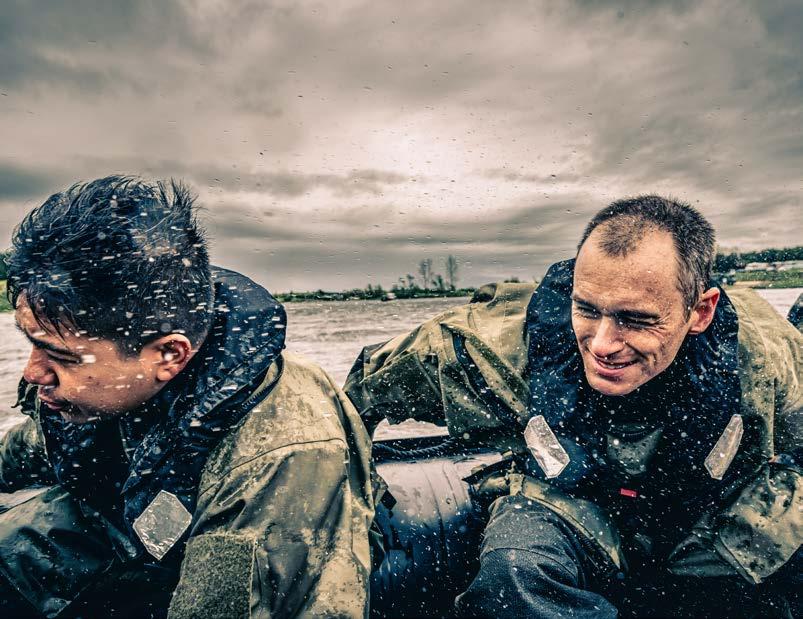
“We got lucky with the weather in Waiouru, it snowed the day we started the search phase of our training,” he smiles. The Search phase involved route, area and building search, focusing on explosive hazards, booby traps and items of interest.
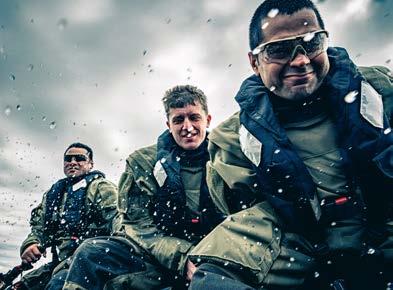
Facing adverse conditions together forms a strong bond between members of the troop, it enhances camaraderie and encourages the troop to work as a team, all skills that are paramount to success, no matter what conditions present themselves.
Sapper Stewart comments that, “If teamwork and communications are good, it makes some of the more physically demanding work easy.”
His highlight on the course was the confidence charge in the demolitions phase of the training.
“It’s the first high explosive you get to set up. It’s the classic explosive setup, you light the fuse and walk away. A brand new skill and fun setting off a big explosion, and a bit of a mixture of nervous excitement,” he says.
The watermanship phase of the training was “really fun,” especially later on in the training after the sappers had come to grips with the requirements.
“We moved into a bit of a mixture of boat handling like the figure of eights, high speed manœuvring, and rafting up. I used a boat, a dingy with an outboard, not long after we completed the training and it had made a huge difference to my skill level. I even had the kids having a go as well.”
The watermanship phase is run over five days at various locations, providing opportunity for the sappers to gain experience on the water in a variety of situations. At successful completion, sappers receive their civilian Royal Yacht Association Level Two (RYA Lvl2) qualification as part of their course too.
Sapper Stewart really enjoyed the course finding it “awesome, well-paced, and with great instructors.”
Any Defence Recruiting enquiries can be directed to 0800 1 FORCE. Each Reserve Force company has its own training programme in line with its battalion’s training focus. Company level training typically occurs one weekend a month with platoon level training occurring once a week.
Starting out as a signals operator in 2007, Sapper Fenil Mistry has enjoyed the camaraderie and experiences the Reserve Force (ResF) has offered. Looking for a different challenge, he applied to internally change corps within the army, enabling him to continue contributing to the ResF.
After his successful corps change to Combat Engineer in 2018, he has undertaken various training, including recently completing his watermanship (military boating) phase of the Basic Combat Engineer ResF course.
He admits that during his university years he was strapped for cash and this was the initial motivator for joining the ResF. Times have changed and so has his perspective.
“As I stayed in, my thoughts changed. I am doing this for someone else now, the country. It’s not about the money anymore. I am there in case something does happen and the government need me to assist,” says the Information Technology (IT) dad of two.
It’s his family which are his driving force too, and he looks on his ResF career as long term and a way to give back. Also
belonging to Palmerston North Search and Rescue, his life is full of giving back to his community and New Zealand.
“I have kids and I want them to do something for the country too. I want them to learn discipline, and skills, and they can see what I do and continue it,” he says.
His varied career has taken him on exercises to Papua New Guinea, Brunei, Australia, throughout New Zealand, and to provide assistance with the 2011 Christchurch earthquake.
It was his time in Christchurch that gave him an insight to see how he could help while serving in the ResF.
“It showed me what Defence does and why you join, to do those sorts of things, like assisting local council and the government,” says Sapper Mistry.
ARMY PEOPLE 23
The exercise was undertaken by member nations of the Five Power Defence Arrangement (FPDA) and is intended to be the most challenging and complex Command Post Exercise (CPX) in the FPDA exercise series. The activity is hosted alternately every five years by Singapore and Malaysia, with Exercise Suman Protector 22 hosted by Singapore.
Suman Protector involved Australia, United Kingdom, Malaysia, Singapore and New Zealand with 280 personnel attending. Its aim was to enhance interoperability among militaries of the FPDA nations and build capabilities to respond to an increasingly complex security environment.

Thirty-one NZDF personnel participated, contributing to the Combined Joint Task Force Headquarters (HQ CJTF) planning
and roles within exercise control. The exercise also included shared learning between participating nations as well as professional development, country briefs and relationship building through cultural and sports activities. NZDF Senior National Representative, Commander Danny Kaye says the exercise is very important for the NZDF’s professional development and relationship building between the FPDA partner nations. “We have a long standing and valued relationship with the FPDA member nations and enjoy the benefits that come from opportunities like this in terms of interoperability, joint training and close engagement with each of the nations. This exercise provides essential development for our people to gain knowledge, skills and experience within the FPDA setting
that builds lasting professional and personal relationships within our FPDA whānau.”
This exercise introduced new
Joint functions to trial which included a Commanders Advisory Group (CAG), a CIMIC cell and a targeting cell. There was also the inclusion of cyber security and information operations.
The CAG included legal, policy, gender, counter terrorism and media advisory cells. The exercise scenario spanned conventional operations to non-conventional and Humanitarian Assistance and Disaster Relief (HADR) which allowed all elements of the HQ CJTF to develop procedures for Joint working groups.
Non-government organisations (NGO’s) and International Organisations such as Red Cross were invited to
participate in the HADR phase. The exercise achieved the outcome of building capacity in the areas of interoperability, HADR planning, and cyber security.
VOLUNTARY EDUCATION STUDY ASSISTANCE
Semester One,
2023 applications are
Applicants should be aware of their responsibilities prior to making an application IAW DFO 3/2016.
Prior to starting the application process, applicants are to:
• Confirm the level of study is right for them with NZDC DLearn
• Advise their 1-up of their study intentions
• Provide supporting paperwork including study documentation from the official learning provider website (ready to attach to your e-form application)
Contact your local DLearn Adult Learning Tutor who can assist you with your application. If you have any further queries, please email our Tertiary Services & Support Advisor at nzdcdlearnvesa@nzdf.mil.nz
24 ARMY PEOPLE
POLICY (terms and conditions) SADFO 3/2016 VESA Policy SADFO 3/2016 VESA Policy (terms and conditions) being accepted.
You may submit your request for funding within 90 days of your study start date. Apply online at NZDC, Defence Learning Toolkit VESA Application (e-form).
The New Zealand Defence Force (NZDF) participated in Exercise Suman Protector 2022 recently.
NZDF PARTICIPATES IN EXERCISE SUMAN PROTECTOR 2022
Art in Recovery Workshop

It’s hoped the recent New Zealand Defence Force (NZDF) Art in Recovery Workshop will be the first of many.
Run with the support of the New Zealand Army, the free, two-day event in Christchurch was open to serving and former Injured, Wounded or Ill personnel from all three Services, and NZ Army Families of the Fallen.
Former aircraft technician Gill McFarlane signed up for the workshop after dealing with symptoms of long-Covid.
“Having Covid-19 and still working and being a mum, there’s always pressure, there’s always stress, and I thought this would be a good way of coming up with some tools for dealing with stress.”
McFarlane deployed to Iraq, Afghanistan and Antarctica while serving with the Royal Air Force and Royal New Zealand Air Force, and is now a health and safety advisor at Base Woodbourne.
She described the workshop as fun, joyful and down-to-earth; she found drawing with pastels to be calming and meditative, and was surprised by how much she enjoyed the poetry exercise.
Those “aha moments” when people discover new activities, are a particular highlight for Elizabeth Love - one of two qualified art therapists who led the workshop.
Love, who previously served in the Royal New Zealand Dental Corps, said the creative arts are important in helping to ease stress.

She said participants were able to dabble in a range of mediums.
“[We] wanted people to go away with the ability, when times are hard, to have places to go in their imagination. They don’t have to wait until after work to reach inside themselves.”
McFarlane is grateful for Veterans’ Affairs and the Returned and Services Association, who sponsored the workshop. She hopes to see similar events at all NZDF camps and bases.

It’s a sentiment echoed by workshop organiser Rebecca Maddaford, Liaison Officer - Injured, Wounded, Ill, who said “In these busy and stressful times, something we should all consider is how we look after ourselves.”
“I would like to see more of these kinds of creative art initiatives available, to support our NZDF whānau to enhance their mental health and wellbeing.”
Gill McFarlane with some of the art she created during the workshop.
Elizabeth Love is one of two art therapists who led the workshop.
(Left to right) Art therapists Elizabeth Love and Sarah Moore, with Papanui RSA President Doug Francis, workshop organiser and NZDF Liaison Officer - Injured, Wounded, Ill Rebecca Maddaford, and Head of Veterans’ Affairs Bernadine Mackenzie. Veterans’ Affairs and the RSA sponsored the workshop.
INTER–SERVICES FOOTBALL
NZ Army Women regain Inter-Service Champion title

NZ Army sent both a men’s and women’s team to the inter-Service football competition. The women’s team was looking to regain the title after coming 2nd in 2019. To add to the pressure the team was looking to reestablish after the Covid break and this saw 13 new cap players, new coaching team and new management for the women’s team. The tournament was looking like it would be a close one as both other services were going through their own rebuilding phase.
Day One – Saw a hard fought game between the reigning champions RNZN vs RNZAF. An early goal to the RNZAF had an upset on the cards, until strong team play and determination led to the RNZN scoring late into 2nd half to earn themselves a draw.


NZ Army Women had a bye this day so they could watch and plot their tilt at the title, seeing both sides in action allowed for some tactics to be discussed in detail.
Day Two – NZ Army Women team faced a determined RNZAF team that was backing up from the game on the previous day. The first half started off with a roar as within the first 2 mins saw Army take the lead as Georgia Fisher tapped in a goal after a poor clearance from the RNZAF. The rest of the half was a back and forth affair where both sides had chances however failed to execute when it counted. The second half the Army came into their own by controlling the tempo and majority of the game play, strong performances from Ruby Reid, Renee Hawley and Charlie Hunt saw opportunities made as striker Georgia Fisher created and finished off two of the chances to complete her hat trick for the game, Final Score 3 Nil leaving everything to play for against Navy.
Day Three – NZ Army Women team were up against the RNZN. As both teams were wanting the title the game started out as a tightly contested affair. Chances for both teams were created and RNZN were unfortunate not to take the lead mid way through the first half after striking the woodwork. Half time both teams were locked up at nil all. The struggle continued into the 2nd half however through strong
performances from Koryn Stewart, Sarah Buchannan and Caitlain Satherley, Army were able to score 2 goals to take out the game.
The win on the final day saw the NZ Army crowned NZDF InterService Champion, The prize giving that evening also saw the following awards being awarded to NZ Army team personnel
“Buckle Cup” for Women’s 2022 Inter-Services Champions NZ Army Women

Women’s Tournament MVP
CPL Charlie Hunt
Women’s Fairest Player of the Tournament
PTE Renee Hawley
The following personnel were selected for the NZDF Football squad to face a Auckland United team on the 2 Oct
Selected for NZDF Women’s XI
CPL Koryn Stewart
LCPL Caitlan Stewart
PTE Renee Hawley
PTE Georgia Fisher
Ms Ruby Reid
SPR Mikaela Bradley
PTE Linsey Jack
CPL Charlie Hunt
The team and management would like to thank all those who enabled successful participation in the tournament including the training camp – and units for releasing players. For anyone wishing to participate or begin playing across the NZ Army Football code the first step is Regionals. The NZ Army Inter-Regionals tournament will be held in August/September 2023 with teams from across Army coming together for a week-long tournament.
ARMYSPORT 27
NZ ARMY MEN ’S FOOTBALL 2022
By A/SGT Cam McLauchlan
The 2022 NZDF Football InterServices tournament was held in Auckland recently.



The 2020/21 football tournaments were cancelled due to Covid-19. NZ Army Men attended the 2022 tournament as reigning champions from 2019 looking to retain the silverware. In the lead up to the tournament, Army held a training camp staged out of Linton Military Camp to bring the numerous new players together and ensure the team was prepared for the tournament. The training camp was led by a new management team (Coach: Sergeant Zach Ansley-Brown and Assistant Coach Sergeant Andy Sawyer who applied a football philosophy pertaining to a 4-3-3 formation with high wingbacks and an aggressive high press out of possession.
Day one of the tournament saw the NZ Army Men team up first playing the RNZN Men. First game of the tournament and the nerves associated with it led to a scrappy first 10 minutes from both teams.
At the 15 minute mark, SPR Nick Wells challenged the RNZN centre forward just inside the defensive box which led to an Oscar winning
performance and the associated penalty being awarded. Fortunately the RNZN striker had spent more time practising diving than penalties and the attempt was not converted. This spurred the NZ Army Men on and after several attacks the RNZN Men succumbed to the pressure with SPR Thomas Hemi (c) receiving a cross and tucking it away in the bottom left corner with a tasty instep volley. Whilst Army managed to dominate possession in the second half we needed to secure the lead. A second goal came from a pinpoint cross to the head of the unmarked A/SGT Cam McLauchlan on the back post. This put the RNZN Men’s chances of a comeback to bed, final score 2 – 0.
Day two: The RNZAF Men’s team put on a masterclass against the bruised and beaten RNZN Men with the final score being 4 – 1. The goal difference from this match meant that the NZ Army Men’s team would have to beat the RNZAF Men’s team to win the trophy whereas a draw would be enough to win it for the RNZAF.
Day three started and the NZ Army Men’s team had a job to do: beat the RNZAF Men to retain the trophy. Kick off happened and immediately it was clear both teams wanted the win with both teams’ players full of determination and hunger. Army drew first blood with a clinical in-swinging free kick placed so perfectly in the top right corner by SPR Thomas Hemi (c) that even the full stretched RNZAF goal keeper couldn’t get near. The game
remained tight and hard fought in the middle of the park. The RNZAF dominated possession and managed to pull two goals back. One of these goals being awarded goal of the tournament from a spectacular long range effort that thundered into the underside of the crossbar and over the line with twenty minutes to go. The senior NZ Army players gripped up the newly capped members of the team and didn’t let a single head drop despite the enormous task left to retain the trophy. Ultra-attacking and defenders join attack was selected and the Army managed to chase down the RNZAF goal keeper who was caught napping at the back for an easy tap in going to PTE Dan Stockton. Score: 2 – 2 with five minutes to go.
The RNZAF attempted to park the bus and hold out for the draw that would see them 2022 InterServices Football Champions, but the NZ Army Men weren’t having it. Wave after wave of onslaught saw pressure mounting on the RNZAF defenders and the ball ended up going out in their defensive third. A long throw delivered by PTE Alistair Wright was flicked onto the penalty spot by SPR Thomas Hemi (c) to A/SGT Cam McLauchlan who brought the ball under control with his chest before lacing it past the wall of Blue. The whistle blew at 90 minutes with the final score being 3 – 2 and the NZ Army Men’s team being crowned the 2022 NZDF Inter-Services Football Men’s Champions.
The team and management would like to thank all those who enabled successful participation in the tournament including the training camp – and units for releasing players. For anyone wishing to participate or begin playing across the NZ Army Football code the first step is Regionals. The NZ Army Inter-Regional’s tournament will be held in August/September 2023 with teams from across Army coming together for a week-long tournament. To attend, submit an LPF1 via your unit chain of command to Army.Football@ nzdf.mil.nz. Attendance at Army Football Inter-Regionals is open to any person posted to an Army Camp – this includes RNZAF/ RNZN personnel and civilians. At the conclusion of Regionals, an Army men’s and Army women’s team will be announced to play at NZDF Football Inter-Services. If you have any questions about NZ Army Football please email Army. Football@nzdf.mil.nz.
Awards
Ann Waldie Memorial (2022 Inter-Service Champions)
NZ Army Men
Men’s Player of the Tournament
A/SGT Cam McLauchlan
Men’s Best and Fairest Player
A/SGT Cam McLauchlan
Selected for NZDF Men’s XI PTE Paddy Brown PTE Dan Stockton PTE Alistair Wright
Nick Wells
Thomas Hemi CPL Freddy Williams A/SGT Cam McLauchlan
28 ARMYSPORT
Army Men’s team crowned the 2022 NZDF InterServices Football Men’s Champions
SPR
SPR
LINTON COBRAS WOMEN’S RUGBY LEAGUE

Between 2014-17 the Linton Cobras Women’s team played in the Wellington Women’s Rugby League Competition which they won in 2014 and 2015. But at the end of 2017, with the game going into recess in Wellington, the Cobras women’s side disbanded.

Rugby League Women’s Competition.
However with the emergence of two local teams from Feilding and Dannevirke, the decision was made re-establish the Cobras Women’s team to compete in the first ever women’s competition in the Manawatu. With the goal of just getting teams to play games, the season was shortened to four games for each team with a final.
The Cobras headed into their first match against Feilding Stags with only four of the 20 players having had any previous rugby league experience. This didn’t deter the team, as the raced to a 20-0 lead within the first 15 minutes, before running away with a historic 58-12 victory.
The second match saw the Cobras play at home in a double header with the men’s side against the Dannevirke Tigers. With the Tigers boasting a much bigger side, the Cobras used their speed to their advantage and secured a 22-6 victory. Their third match saw them travel to Dannevirke for a rematch against the Tigers side in front of their vocal supporters. With some players unavailable and limited players on the bench, the Cobras fought hard to come away with
an impressive 26-14 victory and booked their place in the final.
The last game of the regular season saw the Cobras play at home, but this time against the Feilding Stags. With the Stags now bolstered by the inclusion of Manawatu Rep Rugby players, the Cobras had to dig deep in a brutal contest to hang on to narrow 24-20 victory and finish the regular rounds undefeated.
The final saw the Cobras line up against the much improved Feilding Stags team. However, this time the Cobras were without nine players due to injury or NZDF rugby commitments. The final was a repeat of the previous game between the teams, as both teams went toe to toe for the majority of the match. It took a last minute chip and chase try from Carys Dallinger to secure the championship for the Cobras with a 16-8 victory.
A big shout out to the coaching staff of SGT Abe Erihe, SGT Bridget Lake, CPL Ruth Tietie, CPL Cindy Ries-Rupapera, and SPR Sammy McIntosh-Brown who managed to bring a predominantly rookie squad together to go through the season undefeated. The level of commitment shown by the players was impressive with players traveling from as far as Waiouru and Ohakea to train or play.
With two further teams expressing interest in joining the Competition in 2023, the future is bright for women’s rugby league in the Manawatu.


ARMYSPORT 29
The Linton Cobras Women’s Rugby League team made a come-back after a four year absence when they took part in the inaugural Manawatu
NZ Army Golf Championships 2023 When: 23 January 2023 (Wellington Anniversary) Where: Shandon Golf Club Time: 0730hrs What: 36 Holes Open to all current NZ Army personnel and Veterans 3 Divisions - Prizes for each Division, Gross, Stableford, Nett. Haggle morning and afternoon (long drive & closest to the pin). Registrations CLOSE Wednesday 11 January 2023. No late entries will be accepted. Entries can be emailed to kevin.brophy@nzdf.mil.nz Please include your name, NZ Golf ID and NZ Golf handicap. Entry Fee: $30 to be paid on the day.
FRANCE TRIUMPH AS DEFENCE BONDS FORGED IN INAUGURAL RUGBY COMPETITION
France took the honours in the first women’s International Defence Rugby Competition (IDRC) following an arm wrestle final with New Zealand’s Defence Ferns, with the tournament setting the standard for future events.

Hosts New Zealand led 8-6 at half time but conceded a penalty in front of the posts minutes before fulltime, which the French successfully converted to win 9-8.
In another tough challenge, Fiji beat Australia 36-28 for third place and United Kingdom beat Tonga 44-11 in the Plate final.
It brought a close to more than three weeks of intense rugby as the New Zealand Defence Force (NZDF) welcomed international Defence women from Australia, Fiji, France, Papua New Guinea, Tonga, United Kingdom and Vanuatu.
While competing fiercely on field, the teams cheered each other on and off the field, connecting through their passion for rugby.
Despite losing the hard-fought final, the Defence Ferns had some good news when Navy flanker Kate Williams, who was born in Swansea, was called into the Welsh national team competing in the women’s Rugby World Cup, also being played in New Zealand.
Defence Ferns co-captain Hayley Hutana said they were grateful to have been a part of the first IDRC.
“To be connecting with women from other Defence Forces through rugby and representing your country and organisation is pretty special,” she said.
“The connections and culture formed off the field are special
takeaways from this tournament, and ones we can hold onto and grow for a long time.”
At the closing ceremony, Chief of New Zealand Army and Chair of NZDF Rugby, Major General John Boswell said he was incredibly proud the NZDF had hosted this first women’s competition, enabling Defence women across the world to engage through sport, compete at the highest level and create special bonds.
He said it was a reflection how our armed forces support their people by allowing them to follow their sporting passions alongside their professional lives.
“This tournament has been an incredibly important engagement opportunity for each of our Defence Forces, where players, coaches and support staff, have been able to build on the special relationships and networks that exist between all of our countries.”
It had provided a fantastic ground-breaker which would be built on at the next IDRC, which is proposed to be held in 2026, he said.
Rugby legends Farah Palmer and Sir Wayne (Buck) Shelford, along with Dame Julie Christie, Chair of Rugby World Cup - NZ and Claire Beard, Head of NZ Women’s Rugby presented teams with their medals and trophies.
Before presenting the team’s Most Valuable Player awards, Dr Palmer shared with the more than 300 players coaches, managers, officials and VIPs gathered to mark the official closing, the three Cs, she believed this rugby competition brought to players.
The first two being camaraderie and culture. She reflected that when we play rugby we make friends for life, and share our cultures with each other. She commented on how she had seen many cultures on display at the games and loved the way each team had expressed themselves.
The third was courage.
“You’ve all shown courage doing what you do in Defence and we thank you for that, and you’ve shown courage to be the first to be a part of a tournament like this,” she said.
Defence Minister Peeni Henare presented the inaugural IDRC trophy to the French team.
Families reunited by Army service come together on the rugby field
Two cousins reunited by a twist of fate and the New Zealand Army joined forces on the rugby field.
Lance Corporal (LCPL) Mary Kanace and Second Lieutenant (2LT) Jokaveti Waqanivalu were members of the New Zealand Defence Force team competing in the inaugural women’s International Defence Rugby Competition.




LCPL Kanace’s family moved from Fiji to Manawatū before she was born. Several years later 2LT Waqanivalu and her family also moved to New Zealand where they based themselves in South Auckland, but the relations had lost touch.
In a moment of serendipity both women ended up enlisting in the Army and attending the same basic training course in 2015.
On the day the pair embarked on the course their families gathered for the farewell - a moment that led to their reconnection, and forged a special bond between the two soldiers.
2LT Waqanivalu said she feels lucky to have connected with her distant relations and to have a home away from home in Manawatū while she is posted to Linton Military Camp.
“When I go home Mary’s sisters are my sisters, and her mum is my mum,” 2LT Waqanivalu said.
She said she can feel the bond between her and cousin LCPL Kanace when they’re playing rugby.
“We know where each other are going to be on the field, without having to train for it.”
The pair are hoping to play Fiji in the upcoming finals of the competition as they know a few of the players from their home country.
The two soldiers said those bonds won’t dampen their competitive spirit.
“There’s an extra sort of rivalry. You play hard every game, but you play a little harder when you are going up against your home country,” 2LT Waqanivalu said.
The soldiers joked that their families might show more support for the Fijian team if both sides make it to the finals.
“I think sometimes mum wishes I was playing for Fiji,” LCPL Kanace said.
As they competed side-by-side, they both know their families were proud to be cheering them on together.
“When we all get together, it’s like no time’s been lost,” 2LT Waqanivalu said.
2LT Jokaveti Waganivalu (left) and cousin LCPL Mary Kanace.


























 By 2LT J Corbett, 5/7 RNZIR
By 2LT J Corbett, 5/7 RNZIR



 The 2022 New Zealand Defence Force Reservist of the Year Award winner is Lance Corporal Jason Hart.
The 2022 New Zealand Defence Force Reservist of the Year Award winner is Lance Corporal Jason Hart.






















































































